

Compact Muon Solenoid
LHC, CERN
| CMS-PAS-SMP-23-002 | ||
| Measurement of the W boson mass in proton-proton collisions at $ \sqrt{s} = $ 13 TeV | ||
| CMS Collaboration | ||
| 17 September 2024 | ||
| Abstract: In the standard model of particle physics, the masses of the carriers of the weak interaction, the W and Z bosons, are uniquely related. Physics beyond the standard model can change this relationship through the effects of virtual particle quantum loops, thus making it of paramount importance to measure these masses with the highest possible precision. While the mass of the Z boson is known to the remarkable precision of nearly 20 parts per million (2 MeV), thanks to the CERN LEP experimental program, the W boson mass is known much less precisely. The current precision of a global fit to electroweak data, used to predict the W boson mass in the standard model, yields an uncertainty of 6 MeV, so that reaching a comparable experimental precision would be a sensitive and fundamental test of the standard model. We report the first W boson mass measurement by the CMS Collaboration at the CERN LHC, based on a data sample collected in 2016 at the proton-proton collision energy of 13 TeV. The W boson mass is measured using a sample of $ \mathrm{W}\to\mu\nu $ events via a highly granular maximum likelihood fit to the kinematical distributions of the daughter muons, separated by electric charge. The significant in-situ constraints of theoretical inputs and their corresponding uncertainties provided by this novel approach, together with an accurate determination of the experimental effects, lead to a very precise W boson mass measurement, 80 360.2 $ \pm $ 9.9 MeV, in agreement with the standard model prediction. | ||
|
Links:
CDS record (PDF) ;
CADI line (restricted) ;
These preliminary results are superseded in this paper, Submitted to Nature. The superseded preliminary plots can be found here. |
||
| Figures & Tables | Summary | Additional Figures | References | CMS Publications |
|---|
| Figures | |
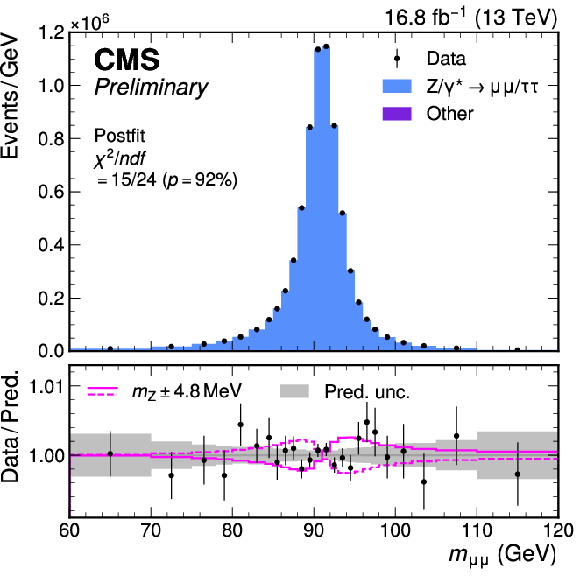
png pdf |
Figure 1:
Measured and simulated $ \mathrm{Z}\to\mu\mu $ dimuon mass distributions. The prediction reflects the best fit parameter values and uncertainties resulting from the maximum likelihood fit. The total uncertainty after the systematic uncertainty profiling procedure (gray band) and the 4.8 MeV uncertainty in the extracted $ m_{\mathrm{Z}} $ value (magenta lines) are also shown. |
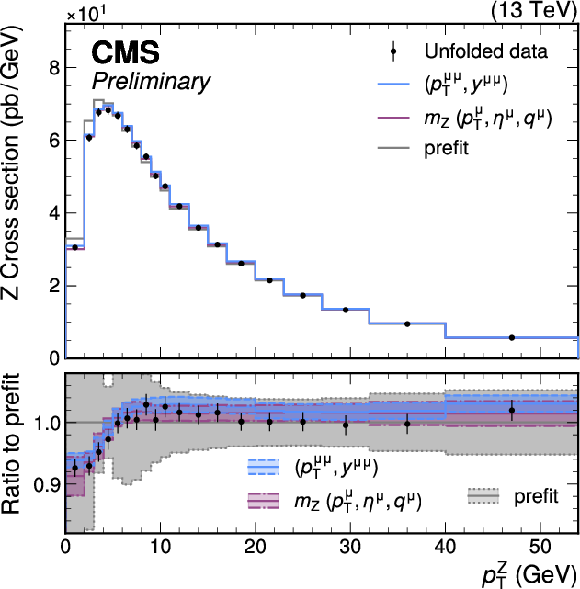
png pdf |
Figure 2:
The generator-level $ p_{\mathrm{T}}^{\mathrm{Z}} $ distribution, compared to the unfolded data, with the prediction and uncertainty before the maximum likelihood fit and with the distribution modified according to the postfit values and uncertainties of the relevant nuisance parameters. The distribution and uncertainties obtained from the W-like $ m_{\mathrm{Z}} $ measurement are shown in purple, whereas the blue band shows the distribution obtained from the direct fit to the $ p_{\mathrm{T}}^{\mu\mu} $ distribution. The generator-level distribution predicted by SCETLIB+DYTURBO (before incorporating the constraints obtained from fits to the data) is shown in black. The ratio of the predictions and unfolded data to the prefit prediction (shown in gray), as well as their uncertainties, are shown by the shaded bands in the bottom panel. |
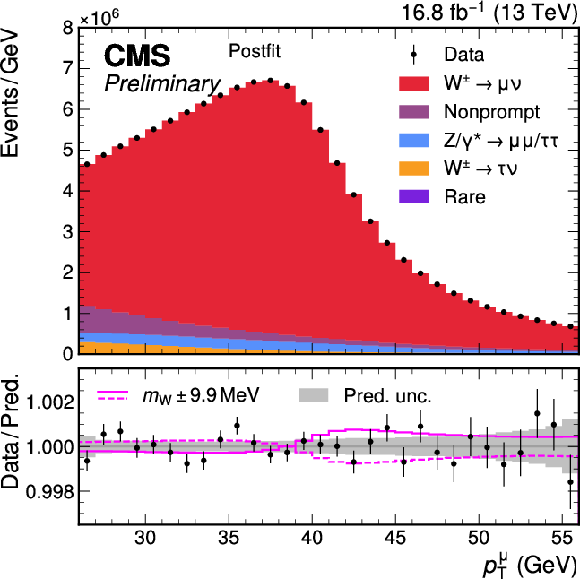
png pdf |
Figure 3:
Measured and simulated $ p_{\mathrm{T}}^{\mu} $ distributions, with the prediction adjusted according to the best fit values of the nuisance parameters obtained from the maximum likelihood fit. The solid and dashed pink lines represent, respectively, an increase and decrease of $ m_{\mathrm{W}} $ by 9.9 MeV. The uncertainties in the predictions, after the systematic uncertainty profiling in the maximum likelihood fit, are shown by the shaded band. |
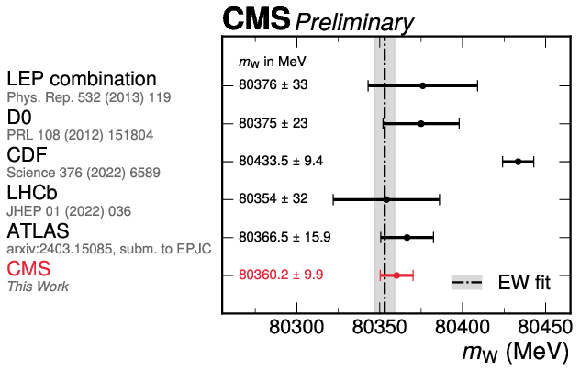
png pdf |
Figure 4:
The $ m_{\mathrm{W}} $ measurement from this analysis (in red) is compared with those of LEP [9], D0 [14], CDF [17], LHCb [19], and ATLAS [20]. The global EW fit prediction [1] is represented by the gray band. |
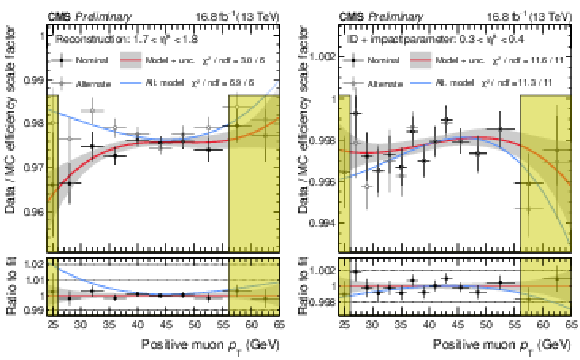
png pdf |
Figure A1:
Measured scale factors (SFs) for muons with positive charge as a function of $ p_{\mathrm{T}}^{\mu} $ in two representative $ \eta^{\mu} $ bins, for the reconstruction (left) and identification (right) selection efficiency. The black (gray) circles are the binned SFs measured with the T&P technique using the nominal (alternative) signal model, with the error bars representing their statistical uncertainty. The solid red (blue) line is the result of the smoothing fit with a third order polynomial for the nominal (alternative) model. The gray band represents the statistical uncertainty from the smoothing of the nominal SFs. The yellow bands represent the regions outside the $ p_{\mathrm{T}}^{\mu} $ range used in the $ m_{\mathrm{W}} $ measurement. |

png pdf |
Figure A1-a:
Measured scale factors (SFs) for muons with positive charge as a function of $ p_{\mathrm{T}}^{\mu} $ in two representative $ \eta^{\mu} $ bins, for the reconstruction (left) and identification (right) selection efficiency. The black (gray) circles are the binned SFs measured with the T&P technique using the nominal (alternative) signal model, with the error bars representing their statistical uncertainty. The solid red (blue) line is the result of the smoothing fit with a third order polynomial for the nominal (alternative) model. The gray band represents the statistical uncertainty from the smoothing of the nominal SFs. The yellow bands represent the regions outside the $ p_{\mathrm{T}}^{\mu} $ range used in the $ m_{\mathrm{W}} $ measurement. |
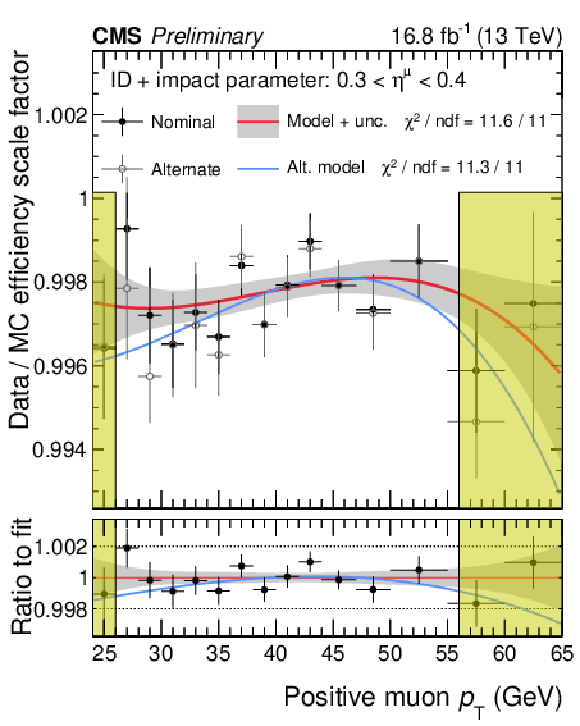
png pdf |
Figure A1-b:
Measured scale factors (SFs) for muons with positive charge as a function of $ p_{\mathrm{T}}^{\mu} $ in two representative $ \eta^{\mu} $ bins, for the reconstruction (left) and identification (right) selection efficiency. The black (gray) circles are the binned SFs measured with the T&P technique using the nominal (alternative) signal model, with the error bars representing their statistical uncertainty. The solid red (blue) line is the result of the smoothing fit with a third order polynomial for the nominal (alternative) model. The gray band represents the statistical uncertainty from the smoothing of the nominal SFs. The yellow bands represent the regions outside the $ p_{\mathrm{T}}^{\mu} $ range used in the $ m_{\mathrm{W}} $ measurement. |
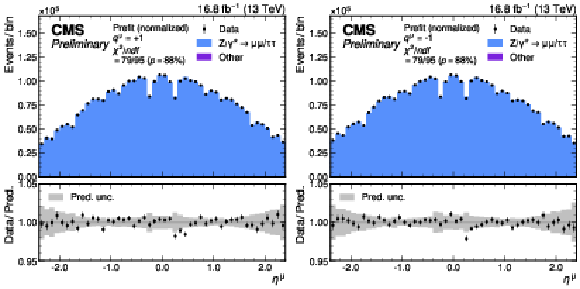
png pdf |
Figure A2:
Measured and predicted $ \eta^{\mu} $ distributions in $ \mathrm{Z}\to\mu\mu $ events with the W-like Z selection for positively (left) and negatively (right) charged muons. The total normalized uncertainties (statistical and systematic) are represented by the shaded bands. |
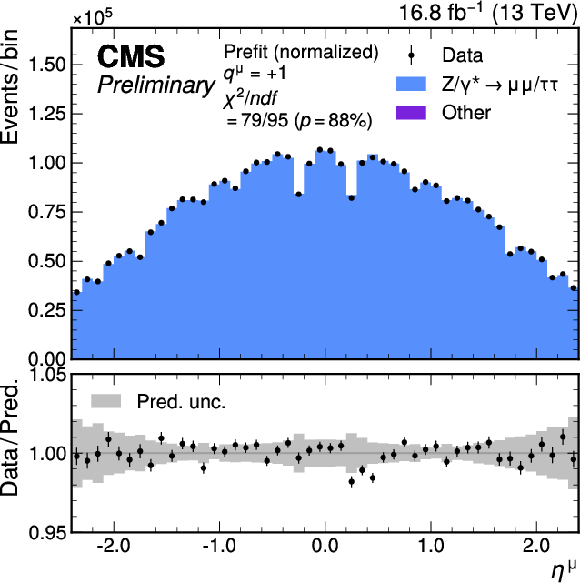
png pdf |
Figure A2-a:
Measured and predicted $ \eta^{\mu} $ distributions in $ \mathrm{Z}\to\mu\mu $ events with the W-like Z selection for positively (left) and negatively (right) charged muons. The total normalized uncertainties (statistical and systematic) are represented by the shaded bands. |
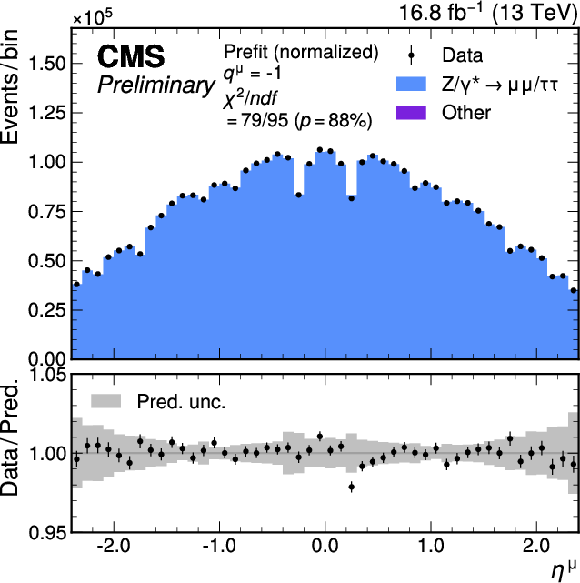
png pdf |
Figure A2-b:
Measured and predicted $ \eta^{\mu} $ distributions in $ \mathrm{Z}\to\mu\mu $ events with the W-like Z selection for positively (left) and negatively (right) charged muons. The total normalized uncertainties (statistical and systematic) are represented by the shaded bands. |
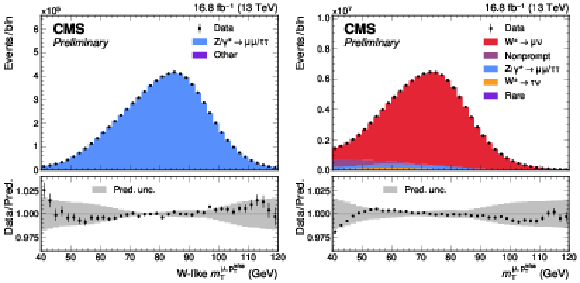
png pdf |
Figure A3:
Measured and predicted $ m_{\mathrm{T}} $ distributions in Z (left) and W (right) events, after calibrating the hadronic recoil. The total normalized uncertainties (statistical and systematic) are represented by the shaded bands. |
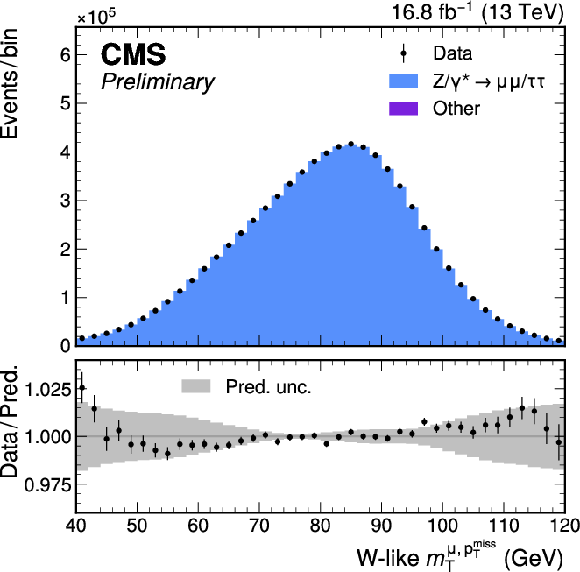
png pdf |
Figure A3-a:
Measured and predicted $ m_{\mathrm{T}} $ distributions in Z (left) and W (right) events, after calibrating the hadronic recoil. The total normalized uncertainties (statistical and systematic) are represented by the shaded bands. |
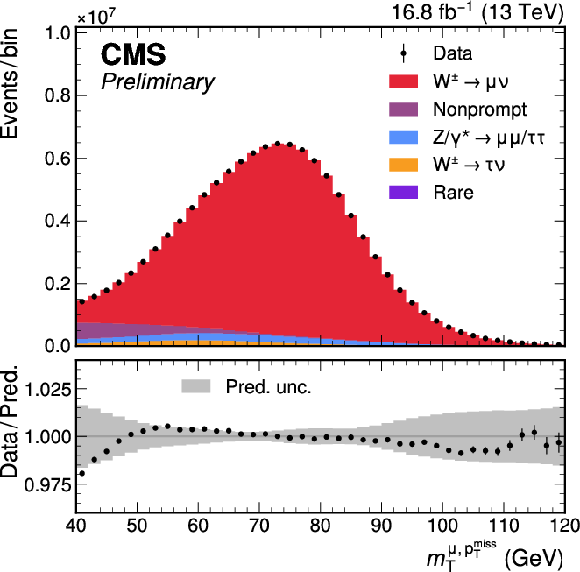
png pdf |
Figure A3-b:
Measured and predicted $ m_{\mathrm{T}} $ distributions in Z (left) and W (right) events, after calibrating the hadronic recoil. The total normalized uncertainties (statistical and systematic) are represented by the shaded bands. |
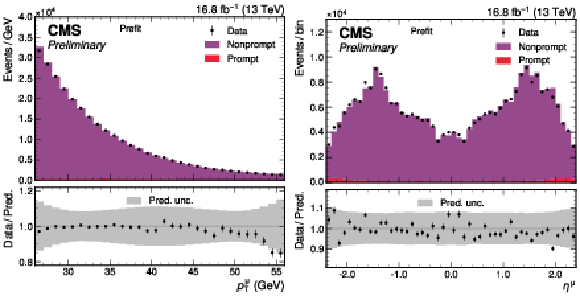
png pdf |
Figure A4:
The observed data and the prediction of the extended ABCD method, as described in the text, for the $ p_{\mathrm{T}}^{\mu} $ (left) and $ \eta^{\mu} $ (right) distributions, in a region enriched in events with nonprompt muons obtained by selecting muons compatible with being produced in a secondary vertex. Small contributions from events with a prompt lepton, evaluated using simulated samples, are shown by the red histogram. The total uncertainties (statistical and systematic) are represented by the shaded bands. |
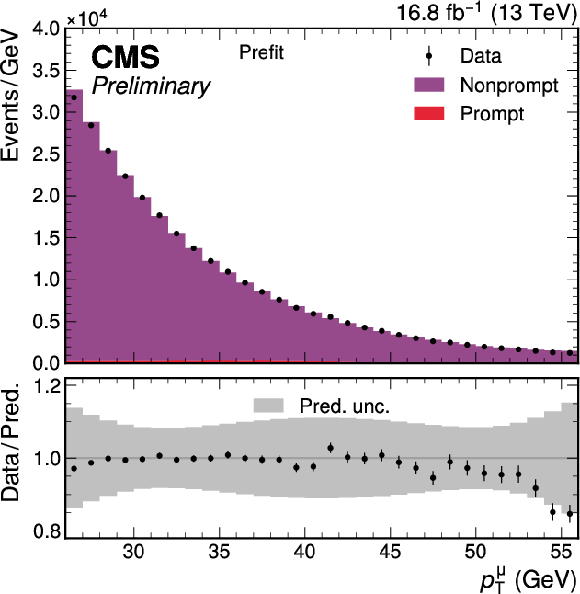
png pdf |
Figure A4-a:
The observed data and the prediction of the extended ABCD method, as described in the text, for the $ p_{\mathrm{T}}^{\mu} $ (left) and $ \eta^{\mu} $ (right) distributions, in a region enriched in events with nonprompt muons obtained by selecting muons compatible with being produced in a secondary vertex. Small contributions from events with a prompt lepton, evaluated using simulated samples, are shown by the red histogram. The total uncertainties (statistical and systematic) are represented by the shaded bands. |
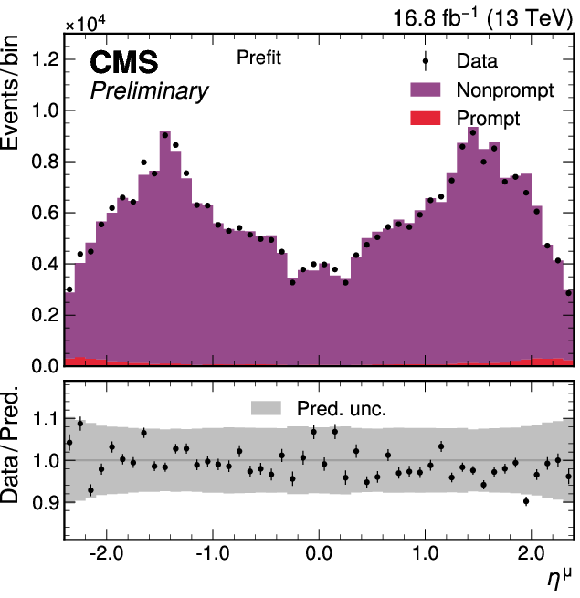
png pdf |
Figure A4-b:
The observed data and the prediction of the extended ABCD method, as described in the text, for the $ p_{\mathrm{T}}^{\mu} $ (left) and $ \eta^{\mu} $ (right) distributions, in a region enriched in events with nonprompt muons obtained by selecting muons compatible with being produced in a secondary vertex. Small contributions from events with a prompt lepton, evaluated using simulated samples, are shown by the red histogram. The total uncertainties (statistical and systematic) are represented by the shaded bands. |
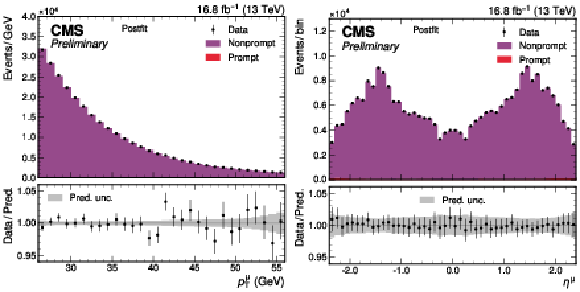
png pdf |
Figure A5:
The observed data and the prediction of the extended ABCD method after a fit to the $ (p_{\mathrm{T}}^{\mu}, \eta^{\mu}, q^{\mu}) $ distribution, as described in the text, for the $ p_{\mathrm{T}}^{\mu} $ (left) and $ \eta^{\mu} $ (right) distributions, in a region enriched in events with nonprompt muons obtained by selecting muons compatible with being produced in a secondary vertex. The upper plots show the prefit prediction and the lower ones show the prediction after a fit to the $ (p_{\mathrm{T}}^{\mu}, \eta^{\mu}, q^{\mu}) $ distribution. Small contributions from events with a prompt lepton, evaluated using simulated samples, are shown by the red histogram. The total uncertainties (statistical and systematic) are represented by the shaded bands. |
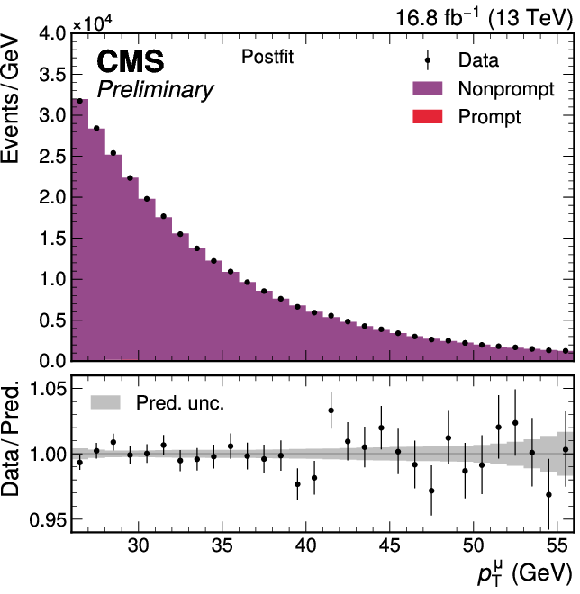
png pdf |
Figure A5-a:
The observed data and the prediction of the extended ABCD method after a fit to the $ (p_{\mathrm{T}}^{\mu}, \eta^{\mu}, q^{\mu}) $ distribution, as described in the text, for the $ p_{\mathrm{T}}^{\mu} $ (left) and $ \eta^{\mu} $ (right) distributions, in a region enriched in events with nonprompt muons obtained by selecting muons compatible with being produced in a secondary vertex. The upper plots show the prefit prediction and the lower ones show the prediction after a fit to the $ (p_{\mathrm{T}}^{\mu}, \eta^{\mu}, q^{\mu}) $ distribution. Small contributions from events with a prompt lepton, evaluated using simulated samples, are shown by the red histogram. The total uncertainties (statistical and systematic) are represented by the shaded bands. |

png pdf |
Figure A5-b:
The observed data and the prediction of the extended ABCD method after a fit to the $ (p_{\mathrm{T}}^{\mu}, \eta^{\mu}, q^{\mu}) $ distribution, as described in the text, for the $ p_{\mathrm{T}}^{\mu} $ (left) and $ \eta^{\mu} $ (right) distributions, in a region enriched in events with nonprompt muons obtained by selecting muons compatible with being produced in a secondary vertex. The upper plots show the prefit prediction and the lower ones show the prediction after a fit to the $ (p_{\mathrm{T}}^{\mu}, \eta^{\mu}, q^{\mu}) $ distribution. Small contributions from events with a prompt lepton, evaluated using simulated samples, are shown by the red histogram. The total uncertainties (statistical and systematic) are represented by the shaded bands. |
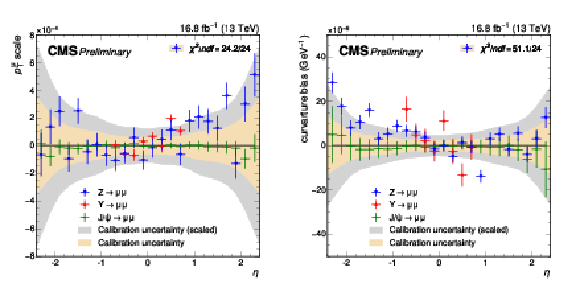
png pdf |
Figure A6:
Charge-independent (left) and charge-dependent (right) closure results from fits using $ \mathrm{J}/\psi $, $ \Upsilon $ (1S), and Z events. The charge-independent closure plot shows an equivalent magnetic field scale factor and the charge-dependent closure plot shows an equivalent misalignment term. The points with error bars represent the scale and statistical uncertainty associated with the closure test, while the band represents the corresponding statistical uncertainty in the calibration parameters themselves, from the $ \mathrm{J}/\psi $ calibration sample. The calibration uncertainties are fully uncorrelated from the Z and $ \Upsilon $ (1S) closure uncertainties, but very strongly correlated with the $ \mathrm{J}/\psi $ closure uncertainties, since they use the same data. |

png pdf |
Figure A6-a:
Charge-independent (left) and charge-dependent (right) closure results from fits using $ \mathrm{J}/\psi $, $ \Upsilon $ (1S), and Z events. The charge-independent closure plot shows an equivalent magnetic field scale factor and the charge-dependent closure plot shows an equivalent misalignment term. The points with error bars represent the scale and statistical uncertainty associated with the closure test, while the band represents the corresponding statistical uncertainty in the calibration parameters themselves, from the $ \mathrm{J}/\psi $ calibration sample. The calibration uncertainties are fully uncorrelated from the Z and $ \Upsilon $ (1S) closure uncertainties, but very strongly correlated with the $ \mathrm{J}/\psi $ closure uncertainties, since they use the same data. |
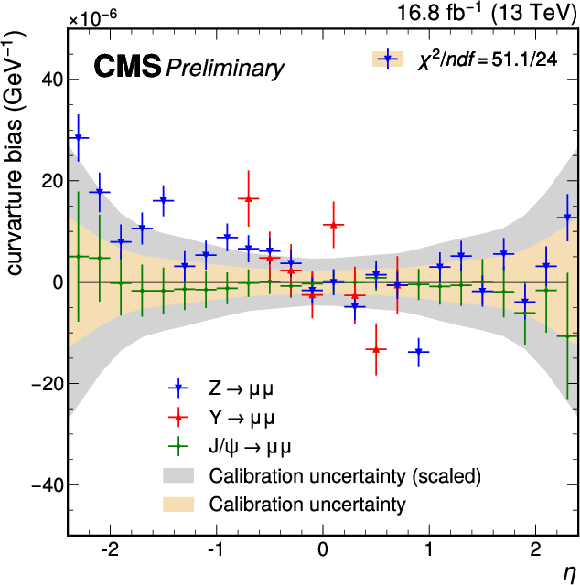
png pdf |
Figure A6-b:
Charge-independent (left) and charge-dependent (right) closure results from fits using $ \mathrm{J}/\psi $, $ \Upsilon $ (1S), and Z events. The charge-independent closure plot shows an equivalent magnetic field scale factor and the charge-dependent closure plot shows an equivalent misalignment term. The points with error bars represent the scale and statistical uncertainty associated with the closure test, while the band represents the corresponding statistical uncertainty in the calibration parameters themselves, from the $ \mathrm{J}/\psi $ calibration sample. The calibration uncertainties are fully uncorrelated from the Z and $ \Upsilon $ (1S) closure uncertainties, but very strongly correlated with the $ \mathrm{J}/\psi $ closure uncertainties, since they use the same data. |

png pdf |
Figure A7:
Measured and simulated $ \mathrm{Z}\to\mu\mu $ dimuon mass distributions, after applying the muon momentum scale and resolution corrections. The normalization of the simulated spectrum is scaled to the measured distribution to better illustrate the agreement between the two $ \mathrm{Z}\to\mu\mu $ line shapes. |
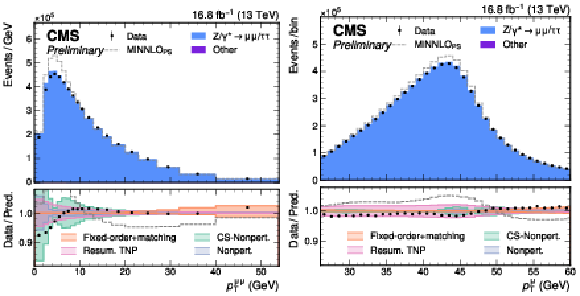
png pdf |
Figure A8:
Measured and simulated $ p_{\mathrm{T}}^{\mu\mu} $ (left) and $ p_{\mathrm{T}}^{\mu} $ (right) distributions in selected $ \mathrm{Z}\to\mu\mu $ events. The standalone uncorrected MINNLO$_{\mathrm{PS}}$ predictions are shown in dashed gray. The nominal predictions (blue) correct the POWHEG MINNLO$_\mathrm{PS}$ $ p_{\mathrm{T}}^{\mathrm{V}} $ with SCETLIB+DYTURBO at N$^{3}$LL+NNLO, as described in the text. Different sources of uncertainty are shown as solid bands in the bottom panel: the fixed-order uncertainty evaluated with $ \mu_{\mathrm{R}} $ and $ \mu_{\mathrm{F}} $ variations and the uncertainty in the resummation and fixed order matching (orange), resummed prediction using theory nuisance parameters (pink), the Collins-Soper (CS) kernel nonperturbative uncertainty (green), and other nonperturbative uncertainties (light blue). These sources of uncertainty impact different ranges of the $ p_{\mathrm{T}}^{\mathrm{V}} $ and $ p_{\mathrm{T}}^{\mu} $ distributions. |

png pdf |
Figure A8-a:
Measured and simulated $ p_{\mathrm{T}}^{\mu\mu} $ distribution in selected $ \mathrm{Z}\to\mu\mu $ events. The standalone uncorrected MINNLO$_{\mathrm{PS}}$ predictions are shown in dashed gray. The nominal predictions (blue) correct the POWHEG MINNLO$_\mathrm{PS}$ $ p_{\mathrm{T}}^{\mathrm{V}} $ with SCETLIB+DYTURBO at N$^{3}$LL+NNLO, as described in the text. Different sources of uncertainty are shown as solid bands in the bottom panel: the fixed-order uncertainty evaluated with $ \mu_{\mathrm{R}} $ and $ \mu_{\mathrm{F}} $ variations and the uncertainty in the resummation and fixed order matching (orange), resummed prediction using theory nuisance parameters (pink), the Collins-Soper (CS) kernel nonperturbative uncertainty (green), and other nonperturbative uncertainties (light blue). These sources of uncertainty impact different ranges of distribution. |

png pdf |
Figure A8-b:
Measured and simulated $ p_{\mathrm{T}}^{\mu} $ distribution in selected $ \mathrm{Z}\to\mu\mu $ events. The standalone uncorrected MINNLO$_{\mathrm{PS}}$ predictions are shown in dashed gray. The nominal predictions (blue) correct the POWHEG MINNLO$_\mathrm{PS}$ $ p_{\mathrm{T}}^{\mathrm{V}} $ with SCETLIB+DYTURBO at N$^{3}$LL+NNLO, as described in the text. Different sources of uncertainty are shown as solid bands in the bottom panel: the fixed-order uncertainty evaluated with $ \mu_{\mathrm{R}} $ and $ \mu_{\mathrm{F}} $ variations and the uncertainty in the resummation and fixed order matching (orange), resummed prediction using theory nuisance parameters (pink), the Collins-Soper (CS) kernel nonperturbative uncertainty (green), and other nonperturbative uncertainties (light blue). These sources of uncertainty impact different ranges of distribution. |
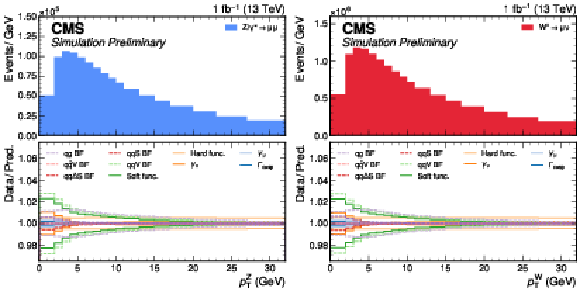
png pdf |
Figure A9:
The predicted $ p_{\mathrm{T}}^{\mathrm{Z}} $ (left) and $ p_{\mathrm{T}}^{\mathrm{W}} $ (right) distributions at generator-level with no selection applied to the muons (or muon and neutrino, in the W case) from the decay. The bottom panel shows the impact in the distribution of the ten theory nuisance parameters described in the text. The label ``BF" refers to the proton beam functions. |
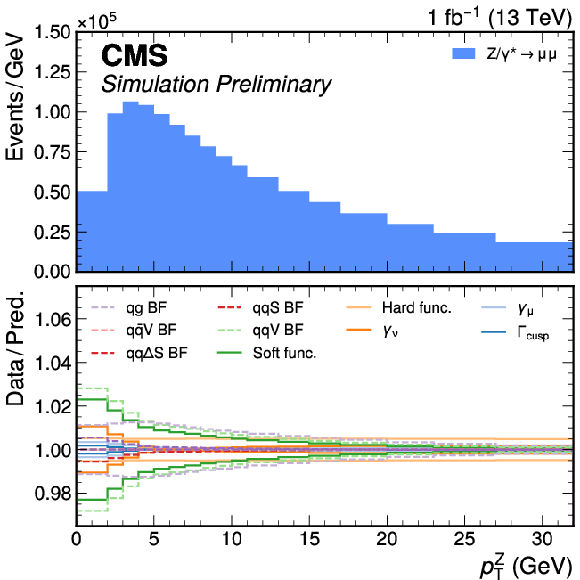
png pdf |
Figure A9-a:
The predicted $ p_{\mathrm{T}}^{\mathrm{Z}} $ (left) and $ p_{\mathrm{T}}^{\mathrm{W}} $ (right) distributions at generator-level with no selection applied to the muons (or muon and neutrino, in the W case) from the decay. The bottom panel shows the impact in the distribution of the ten theory nuisance parameters described in the text. The label ``BF" refers to the proton beam functions. |

png pdf |
Figure A9-b:
The predicted $ p_{\mathrm{T}}^{\mathrm{Z}} $ (left) and $ p_{\mathrm{T}}^{\mathrm{W}} $ (right) distributions at generator-level with no selection applied to the muons (or muon and neutrino, in the W case) from the decay. The bottom panel shows the impact in the distribution of the ten theory nuisance parameters described in the text. The label ``BF" refers to the proton beam functions. |
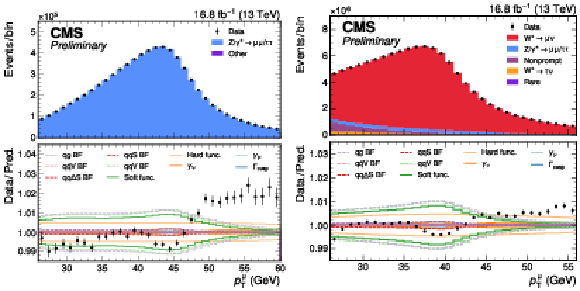
png pdf |
Figure A10:
The predicted $ p_{\mathrm{T}}^{\mu} $ distribution for Z (left) and W (right) events, normalized to the number of data events, compared to the observed data. The bottom panel shows the impact on the distribution of the ten theory nuisance parameters described in the text. The label ``BF" refers to the proton beam functions. |
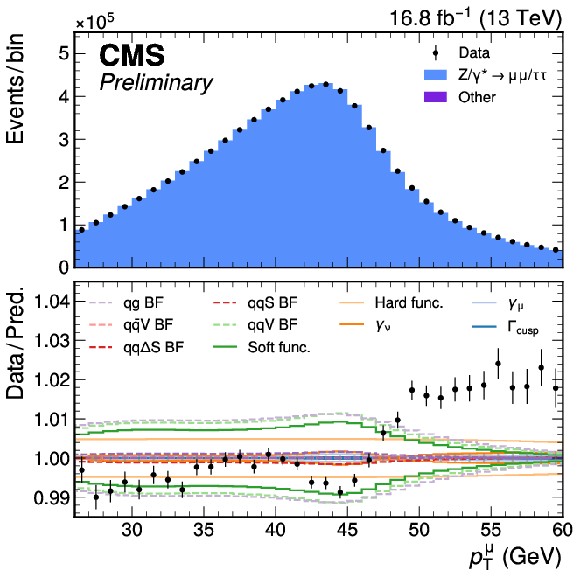
png pdf |
Figure A10-a:
The predicted $ p_{\mathrm{T}}^{\mu} $ distribution for Z (left) and W (right) events, normalized to the number of data events, compared to the observed data. The bottom panel shows the impact on the distribution of the ten theory nuisance parameters described in the text. The label ``BF" refers to the proton beam functions. |

png pdf |
Figure A10-b:
The predicted $ p_{\mathrm{T}}^{\mu} $ distribution for Z (left) and W (right) events, normalized to the number of data events, compared to the observed data. The bottom panel shows the impact on the distribution of the ten theory nuisance parameters described in the text. The label ``BF" refers to the proton beam functions. |
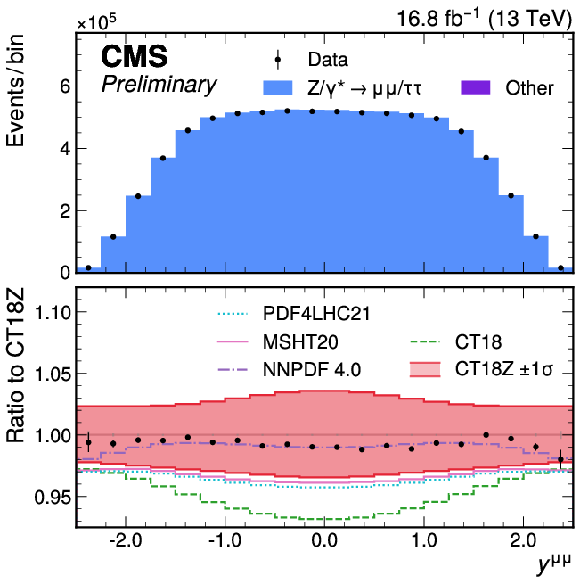
png pdf |
Figure A11:
Measured and predicted dimuon rapidity distributions for $ \mathrm{Z}\to\mu\mu $ events. The nominal prediction, obtained with the CT18Z PDF set, is shown in filled light red. The uncertainty, evaluated as the sum of the eigenvector variation sets, is represented by the filled band in the lower panel. The predictions using the PDF4LHC21, MSHT20, NNPDF4.0, and CT18 sets are also shown (without uncertainty bands). |
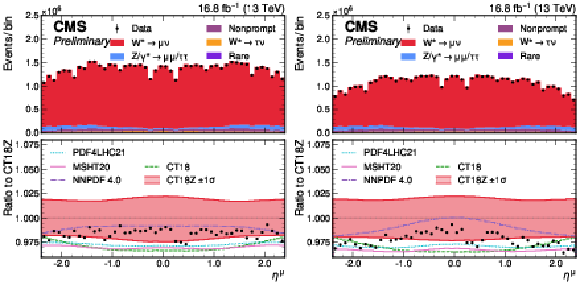
png pdf |
Figure A12:
Measured and predicted $ \eta^{\mu} $ distributions for selected $ \mathrm{W^+} $ (left) and $ \mathrm{W^-} $ (right) events. The nominal prediction, obtained with the CT18Z PDF set, is shown in filled light red. The uncertainty, evaluated as the sum of the eigenvector variation sets, is represented by the filled band in the lower panel. The predictions using the PDF4LHC21, MSHT20, NNPDF4.0, and CT18 sets are also shown (without uncertainty bands). |
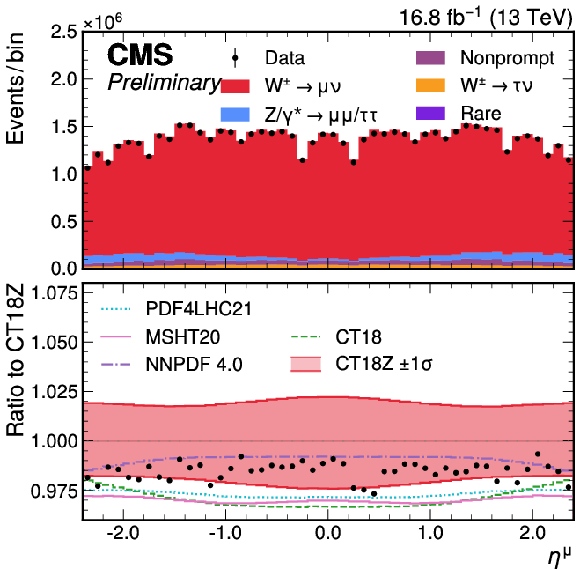
png pdf |
Figure A12-a:
Measured and predicted $ \eta^{\mu} $ distributions for selected $ \mathrm{W^+} $ (left) and $ \mathrm{W^-} $ (right) events. The nominal prediction, obtained with the CT18Z PDF set, is shown in filled light red. The uncertainty, evaluated as the sum of the eigenvector variation sets, is represented by the filled band in the lower panel. The predictions using the PDF4LHC21, MSHT20, NNPDF4.0, and CT18 sets are also shown (without uncertainty bands). |
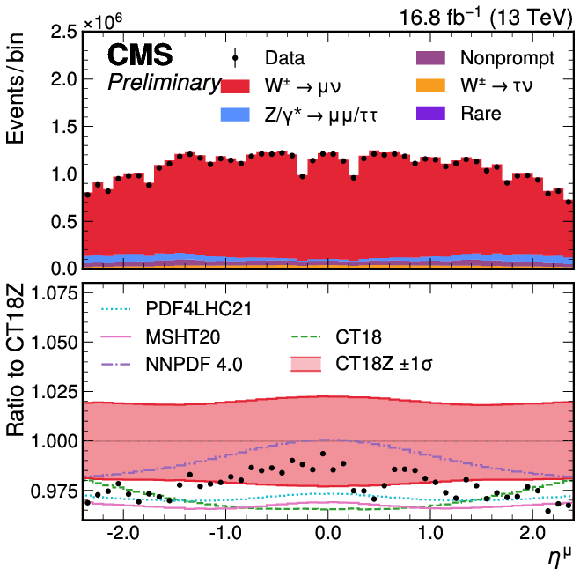
png pdf |
Figure A12-b:
Measured and predicted $ \eta^{\mu} $ distributions for selected $ \mathrm{W^+} $ (left) and $ \mathrm{W^-} $ (right) events. The nominal prediction, obtained with the CT18Z PDF set, is shown in filled light red. The uncertainty, evaluated as the sum of the eigenvector variation sets, is represented by the filled band in the lower panel. The predictions using the PDF4LHC21, MSHT20, NNPDF4.0, and CT18 sets are also shown (without uncertainty bands). |
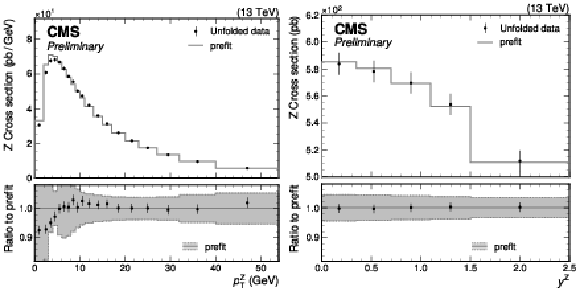
png pdf |
Figure A13:
Unfolded differential cross sections as function of $ p_{\mathrm{T}}^{\mathrm{Z}} $ (left) and $ |y^{\mathrm{Z}}| $ (right) compared to the prefit prediction. |
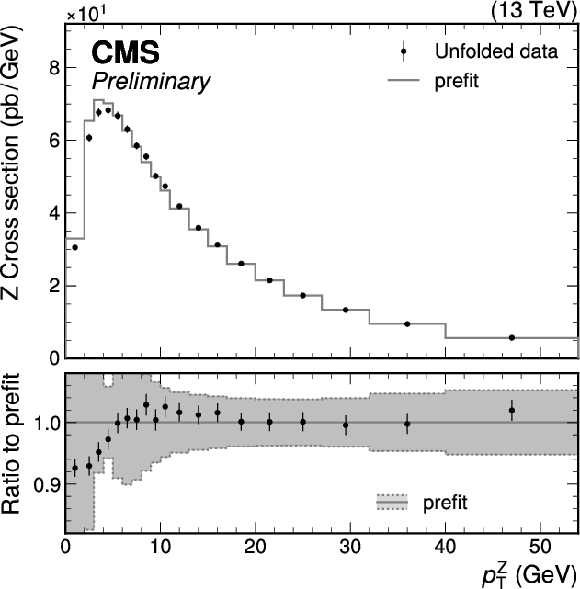
png pdf |
Figure A13-a:
Unfolded differential cross sections as function of $ p_{\mathrm{T}}^{\mathrm{Z}} $ (left) and $ |y^{\mathrm{Z}}| $ (right) compared to the prefit prediction. |
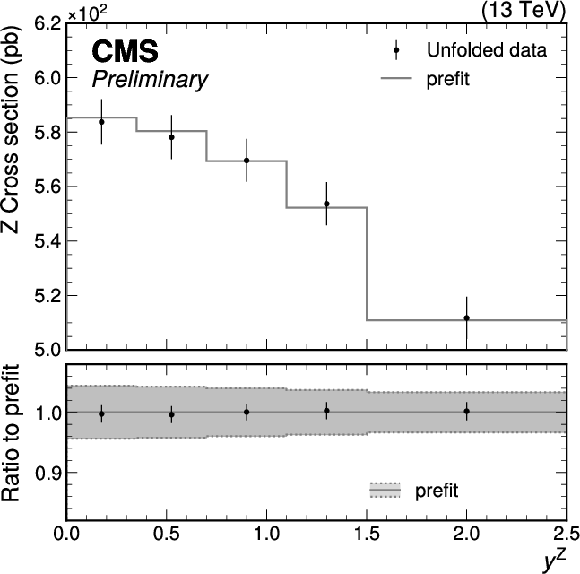
png pdf |
Figure A13-b:
Unfolded differential cross sections as function of $ p_{\mathrm{T}}^{\mathrm{Z}} $ (left) and $ |y^{\mathrm{Z}}| $ (right) compared to the prefit prediction. |
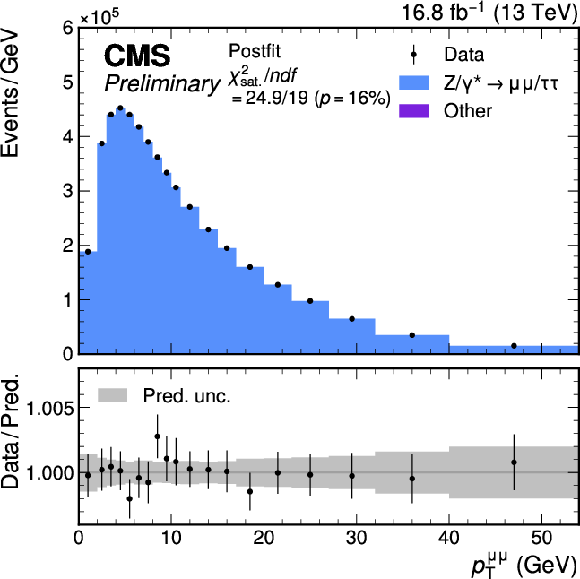
png pdf |
Figure A14:
Measured and simulated $ p_{\mathrm{T}}^{\mu\mu} $ distributions in the Z boson events, with the normalization and uncertainties of the prediction set to the post-fit values. The gray band represents the total systematic uncertainty. |
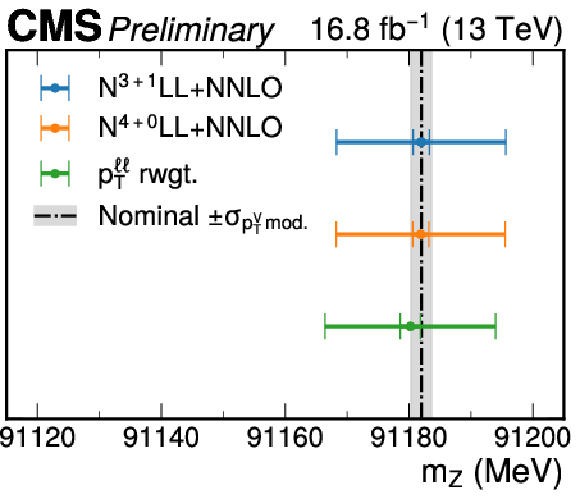
png pdf |
Figure A15:
Comparison of the nominal result and its theory uncertainty, using SCETLIB+DYTURBO at N$^{3}$LL+NNLO, with the value of $ m_{\mathrm{W}} $ measured when using alternative approaches to the $ p_{\mathrm{T}}^{\mathrm{Z}} $ modeling and its uncertainty. The impact of correcting the $ p_{\mathrm{T}}^{\mathrm{Z}} $ distribution directly to the $ p_{\mathrm{T}}^{\mu\mu} $ data, via bin-by-bin reweighting, is also shown. The dash-dotted black line represents the nominal result, while the shaded gray band shows the $ p_{\mathrm{T}}^{\mathrm{Z}} $-modeling uncertainty. The results from alternative approaches to the $ p_{\mathrm{T}}^{\mathrm{Z}} $-modeling and uncertainty are shown as points. The $ p_{\mathrm{T}}^{\mathrm{Z}} $-modeling uncertainties are shown as the inner bars, while the outer bars denote the total uncertainty. |
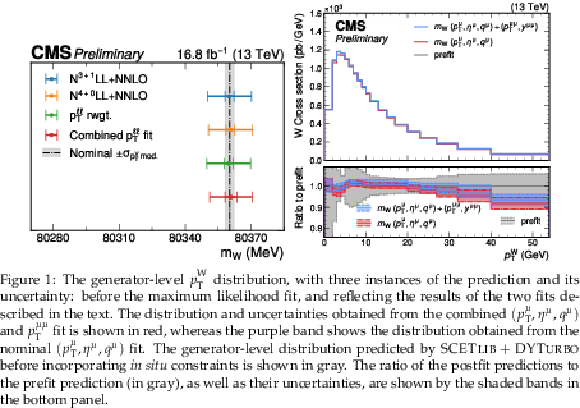
png pdf |
Figure A16:
Comparison of the nominal result and its theory uncertainty, using SCETLIB+DYTURBO at N$^{3}$LL+NNLO, with the value of $ m_{\mathrm{W}} $ measured when using alternative approaches to the $ p_{\mathrm{T}}^{\mathrm{W}} $ modeling and its uncertainty. The impact of correcting the $ p_{\mathrm{T}}^{\mathrm{W}} $ distribution with the $ p_{\mathrm{T}}^{\mu\mu} $ data, both via bin-by-bin reweighting corrections and via a simultaneous maximum likelihood fit, is also shown. The dash-dotted black line represents the nominal result, while the shaded gray band shows the $ p_{\mathrm{T}}^{\mathrm{W}} $-modeling uncertainty. The results from alternative approaches to the $ p_{\mathrm{T}}^{\mathrm{W}} $-modeling and uncertainty are shown as points. The $ p_{\mathrm{T}}^{\mathrm{W}} $-modeling uncertainties are shown as the inner bars, while the outer bars denote the total uncertainty. |
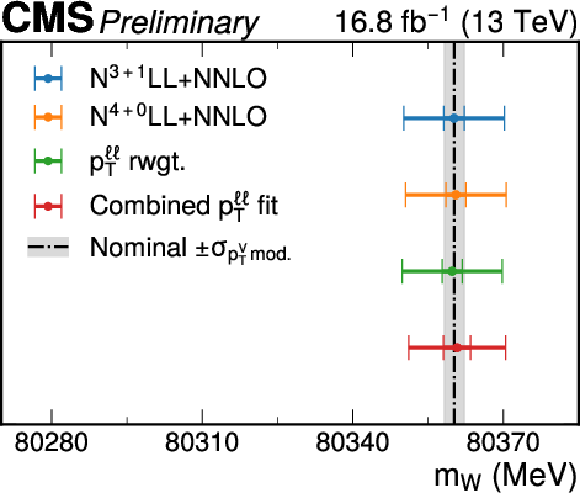
png pdf |
Figure A16-a:
Comparison of the nominal result and its theory uncertainty, using SCETLIB+DYTURBO at N$^{3}$LL+NNLO, with the value of $ m_{\mathrm{W}} $ measured when using alternative approaches to the $ p_{\mathrm{T}}^{\mathrm{W}} $ modeling and its uncertainty. The impact of correcting the $ p_{\mathrm{T}}^{\mathrm{W}} $ distribution with the $ p_{\mathrm{T}}^{\mu\mu} $ data, both via bin-by-bin reweighting corrections and via a simultaneous maximum likelihood fit, is also shown. The dash-dotted black line represents the nominal result, while the shaded gray band shows the $ p_{\mathrm{T}}^{\mathrm{W}} $-modeling uncertainty. The results from alternative approaches to the $ p_{\mathrm{T}}^{\mathrm{W}} $-modeling and uncertainty are shown as points. The $ p_{\mathrm{T}}^{\mathrm{W}} $-modeling uncertainties are shown as the inner bars, while the outer bars denote the total uncertainty. |

png pdf |
Figure A16-b:
Comparison of the nominal result and its theory uncertainty, using SCETLIB+DYTURBO at N$^{3}$LL+NNLO, with the value of $ m_{\mathrm{W}} $ measured when using alternative approaches to the $ p_{\mathrm{T}}^{\mathrm{W}} $ modeling and its uncertainty. The impact of correcting the $ p_{\mathrm{T}}^{\mathrm{W}} $ distribution with the $ p_{\mathrm{T}}^{\mu\mu} $ data, both via bin-by-bin reweighting corrections and via a simultaneous maximum likelihood fit, is also shown. The dash-dotted black line represents the nominal result, while the shaded gray band shows the $ p_{\mathrm{T}}^{\mathrm{W}} $-modeling uncertainty. The results from alternative approaches to the $ p_{\mathrm{T}}^{\mathrm{W}} $-modeling and uncertainty are shown as points. The $ p_{\mathrm{T}}^{\mathrm{W}} $-modeling uncertainties are shown as the inner bars, while the outer bars denote the total uncertainty. |
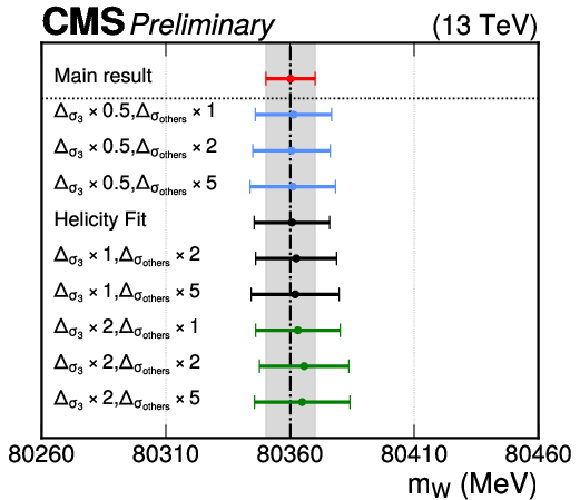
png pdf |
Figure A17:
Measured W boson mass with the helicity fit for different scaling scenarios of the prefit helicity cross section uncertainties, compared with the main result. The initial uncertainties of the $ \sigma_3 $ component and of the other components are denoted as $ \Delta_{\sigma_3} $ and $ \Delta_{\sigma_{\text{others}}} $, respectively. |
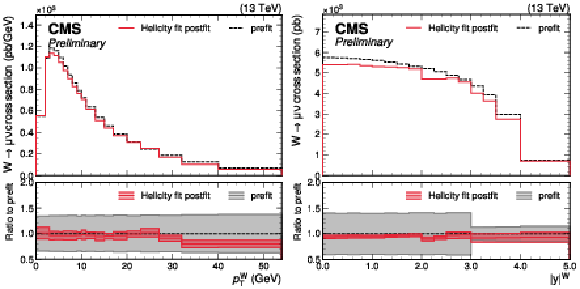
png pdf |
Figure A18:
Extraction of the differential cross section as a function of the W boson transverse momentum (left) and rapidity (right) from the muon $ (p_{\mathrm{T}}^{\mu}, \eta^{\mu}, q^{\mu}) $ distributions in data, using the helicity fit approach. The generator-level distributions predicted by SCETLIB+DYTURBO before incorporating in-situ constraints are shown in gray. The ratio of the postfit predictions (in red) to the prefit prediction (in gray), as well as their uncertainties, are shown by the shaded bands in the bottom panel. |
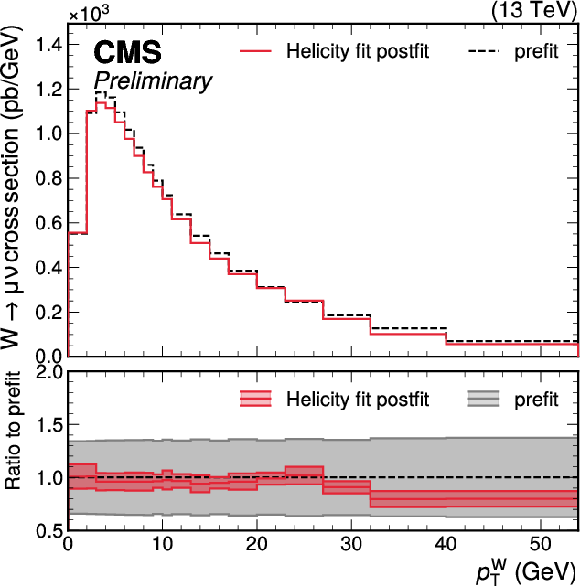
png pdf |
Figure A18-a:
Extraction of the differential cross section as a function of the W boson transverse momentum (left) and rapidity (right) from the muon $ (p_{\mathrm{T}}^{\mu}, \eta^{\mu}, q^{\mu}) $ distributions in data, using the helicity fit approach. The generator-level distributions predicted by SCETLIB+DYTURBO before incorporating in-situ constraints are shown in gray. The ratio of the postfit predictions (in red) to the prefit prediction (in gray), as well as their uncertainties, are shown by the shaded bands in the bottom panel. |

png pdf |
Figure A18-b:
Extraction of the differential cross section as a function of the W boson transverse momentum (left) and rapidity (right) from the muon $ (p_{\mathrm{T}}^{\mu}, \eta^{\mu}, q^{\mu}) $ distributions in data, using the helicity fit approach. The generator-level distributions predicted by SCETLIB+DYTURBO before incorporating in-situ constraints are shown in gray. The ratio of the postfit predictions (in red) to the prefit prediction (in gray), as well as their uncertainties, are shown by the shaded bands in the bottom panel. |
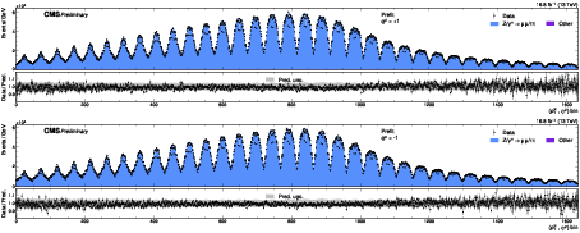
png pdf |
Figure A19:
Measured and simulated $ (p_{\mathrm{T}}^{\mu}, \eta^{\mu}) $ distributions used in the W-like $ m_{\mathrm{Z}} $ measurement, for positively (upper) and negatively (lower) charged muons. The two-dimensional distribution is ``unrolled" such that each bin on the $ x $-axis represents one $ (p_{\mathrm{T}}^{\mu}, \eta^{\mu}) $ cell. The gray band represents the uncertainty in the prediction, before the fit to the data. |

png pdf |
Figure A19-a:
Measured and simulated $ (p_{\mathrm{T}}^{\mu}, \eta^{\mu}) $ distributions used in the W-like $ m_{\mathrm{Z}} $ measurement, for positively (upper) and negatively (lower) charged muons. The two-dimensional distribution is ``unrolled" such that each bin on the $ x $-axis represents one $ (p_{\mathrm{T}}^{\mu}, \eta^{\mu}) $ cell. The gray band represents the uncertainty in the prediction, before the fit to the data. |

png pdf |
Figure A19-b:
Measured and simulated $ (p_{\mathrm{T}}^{\mu}, \eta^{\mu}) $ distributions used in the W-like $ m_{\mathrm{Z}} $ measurement, for positively (upper) and negatively (lower) charged muons. The two-dimensional distribution is ``unrolled" such that each bin on the $ x $-axis represents one $ (p_{\mathrm{T}}^{\mu}, \eta^{\mu}) $ cell. The gray band represents the uncertainty in the prediction, before the fit to the data. |

png pdf |
Figure A20:
Measured and simulated $ (p_{\mathrm{T}}^{\mu}, \eta^{\mu}) $ distributions for positively (upper) and negatively (lower) charged muons. The two-dimensional distribution is ``unrolled" such that each bin on the $ x $-axis represents one $ (p_{\mathrm{T}}^{\mu}, \eta^{\mu}) $ cell. The gray band represents the uncertainty in the prediction, before the fit to the data. |

png pdf |
Figure A20-a:
Measured and simulated $ (p_{\mathrm{T}}^{\mu}, \eta^{\mu}) $ distributions for positively (upper) and negatively (lower) charged muons. The two-dimensional distribution is ``unrolled" such that each bin on the $ x $-axis represents one $ (p_{\mathrm{T}}^{\mu}, \eta^{\mu}) $ cell. The gray band represents the uncertainty in the prediction, before the fit to the data. |

png pdf |
Figure A20-b:
Measured and simulated $ (p_{\mathrm{T}}^{\mu}, \eta^{\mu}) $ distributions for positively (upper) and negatively (lower) charged muons. The two-dimensional distribution is ``unrolled" such that each bin on the $ x $-axis represents one $ (p_{\mathrm{T}}^{\mu}, \eta^{\mu}) $ cell. The gray band represents the uncertainty in the prediction, before the fit to the data. |
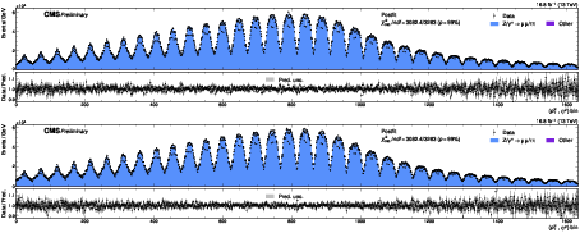
png pdf |
Figure A21:
Measured and simulated $ (p_{\mathrm{T}}^{\mu}, \eta^{\mu}) $ distributions used in the W-like $ m_{\mathrm{Z}} $ measurement, for positively (upper) and negatively (lower) charged muons. The predictions and their uncertainties are adjusted to the best fit values obtained from the maximum likelihood fit. The two-dimensional distribution is ``unrolled" such that each bin on the $ x $-axis represents one $ (p_{\mathrm{T}}^{\mu}, \eta^{\mu}) $ cell. The gray band represents the full uncertainty in the prediction, after the nuisances parameters are adjusted to the best fit values. |

png pdf |
Figure A21-a:
Measured and simulated $ (p_{\mathrm{T}}^{\mu}, \eta^{\mu}) $ distributions used in the W-like $ m_{\mathrm{Z}} $ measurement, for positively (upper) and negatively (lower) charged muons. The predictions and their uncertainties are adjusted to the best fit values obtained from the maximum likelihood fit. The two-dimensional distribution is ``unrolled" such that each bin on the $ x $-axis represents one $ (p_{\mathrm{T}}^{\mu}, \eta^{\mu}) $ cell. The gray band represents the full uncertainty in the prediction, after the nuisances parameters are adjusted to the best fit values. |

png pdf |
Figure A21-b:
Measured and simulated $ (p_{\mathrm{T}}^{\mu}, \eta^{\mu}) $ distributions used in the W-like $ m_{\mathrm{Z}} $ measurement, for positively (upper) and negatively (lower) charged muons. The predictions and their uncertainties are adjusted to the best fit values obtained from the maximum likelihood fit. The two-dimensional distribution is ``unrolled" such that each bin on the $ x $-axis represents one $ (p_{\mathrm{T}}^{\mu}, \eta^{\mu}) $ cell. The gray band represents the full uncertainty in the prediction, after the nuisances parameters are adjusted to the best fit values. |
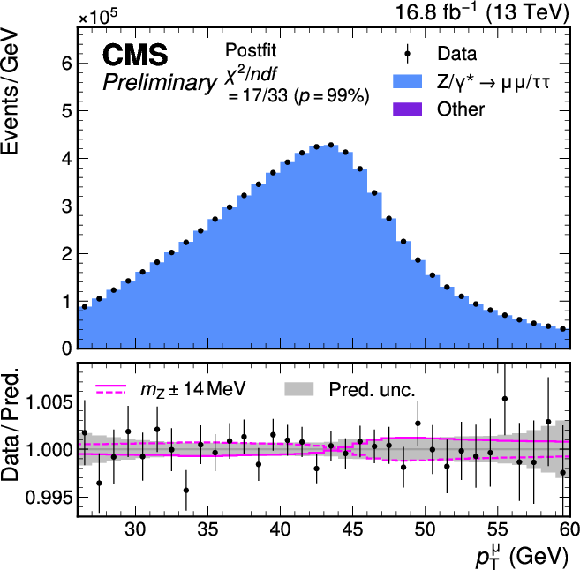
png pdf |
Figure A22:
Measured and simulated $ p_{\mathrm{T}}^{\mu} $ distributions, with the prediction adjusted according to the best fit values of nuisance parameters obtained from the maximum likelihood fit of the W-like $ m_{\mathrm{Z}} $ analysis. The solid and dashed purple lines represent, respectively, an increase and decrease of $ m_{\mathrm{Z}} $ by 9.9 MeV. The uncertainties in the predictions, after the systematic uncertainty profiling in the maximum likelihood fit, are shown by the shaded band. |
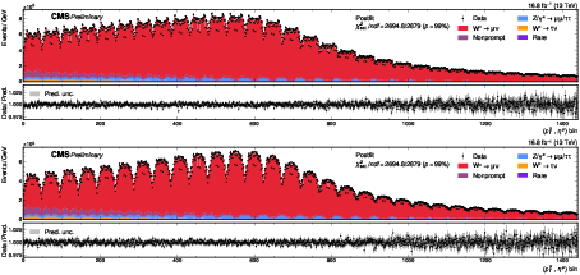
png pdf |
Figure A23:
Measured and simulated $ (p_{\mathrm{T}}^{\mu}, \eta^{\mu}) $ distributions used in the $ m_{\mathrm{W}} $ measurement, for positively (upper) and negatively (lower) charged muons. The predictions and their uncertainties are adjusted to the best fit values obtained from the maximum likelihood fit. The two-dimensional distribution is ``unrolled" such that each bin on the $ x $-axis represents one $ (p_{\mathrm{T}}^{\mu}, \eta^{\mu}) $ cell. The gray band represents the full uncertainty in the prediction, after the nuisances parameters are adjusted to the best fit values. |

png pdf |
Figure A23-a:
Measured and simulated $ (p_{\mathrm{T}}^{\mu}, \eta^{\mu}) $ distributions used in the $ m_{\mathrm{W}} $ measurement, for positively (upper) and negatively (lower) charged muons. The predictions and their uncertainties are adjusted to the best fit values obtained from the maximum likelihood fit. The two-dimensional distribution is ``unrolled" such that each bin on the $ x $-axis represents one $ (p_{\mathrm{T}}^{\mu}, \eta^{\mu}) $ cell. The gray band represents the full uncertainty in the prediction, after the nuisances parameters are adjusted to the best fit values. |

png pdf |
Figure A23-b:
Measured and simulated $ (p_{\mathrm{T}}^{\mu}, \eta^{\mu}) $ distributions used in the $ m_{\mathrm{W}} $ measurement, for positively (upper) and negatively (lower) charged muons. The predictions and their uncertainties are adjusted to the best fit values obtained from the maximum likelihood fit. The two-dimensional distribution is ``unrolled" such that each bin on the $ x $-axis represents one $ (p_{\mathrm{T}}^{\mu}, \eta^{\mu}) $ cell. The gray band represents the full uncertainty in the prediction, after the nuisances parameters are adjusted to the best fit values. |
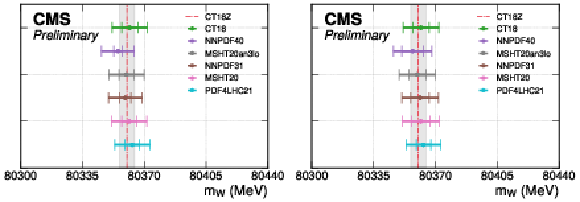
png pdf |
Figure A24:
Measured $ m_{\mathrm{W}} $ values, for seven recent PDF sets, when using the original uncertainty for the given set (left) and when the uncertainties are scaled to accommodate the central prediction of the other sets (right). Each point corresponds to the result obtained when using the indicated PDF set and its uncertainty for the simulated predictions. The inner bar shows the uncertainty from the PDF, and the outer bar shows the total uncertainty. The nominal result, using CT18Z, is shown by the red line, with the CT18Z PDF uncertainty shown in light gray. The scaling procedure improves the consistency of the $ m_{\mathrm{W}} $ values across the PDF sets and with the nominal result. |

png pdf |
Figure A24-a:
Measured $ m_{\mathrm{W}} $ values, for seven recent PDF sets, when using the original uncertainty for the given set (left) and when the uncertainties are scaled to accommodate the central prediction of the other sets (right). Each point corresponds to the result obtained when using the indicated PDF set and its uncertainty for the simulated predictions. The inner bar shows the uncertainty from the PDF, and the outer bar shows the total uncertainty. The nominal result, using CT18Z, is shown by the red line, with the CT18Z PDF uncertainty shown in light gray. The scaling procedure improves the consistency of the $ m_{\mathrm{W}} $ values across the PDF sets and with the nominal result. |
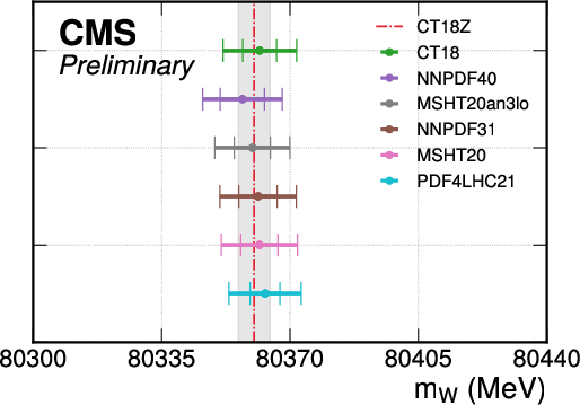
png pdf |
Figure A24-b:
Measured $ m_{\mathrm{W}} $ values, for seven recent PDF sets, when using the original uncertainty for the given set (left) and when the uncertainties are scaled to accommodate the central prediction of the other sets (right). Each point corresponds to the result obtained when using the indicated PDF set and its uncertainty for the simulated predictions. The inner bar shows the uncertainty from the PDF, and the outer bar shows the total uncertainty. The nominal result, using CT18Z, is shown by the red line, with the CT18Z PDF uncertainty shown in light gray. The scaling procedure improves the consistency of the $ m_{\mathrm{W}} $ values across the PDF sets and with the nominal result. |

png pdf |
Figure A25:
The $ m_{\mathrm{Z}} $ fit split in three bins of kinematics of the two muons: $ |\eta^{\mu}| $ (both central, one central and one forward, and both forward) on the left, and $ \eta^{\mu} $ (both negative, one positive and one negative, and both positive) on the right. The result of a fit with three $ m_{\mathrm{Z}} $ parameters is compared the nominal $ m_{\mathrm{Z}} $ fit result and the $ \chi^2 $-like compatibility of the two fits is also shown, as assessed via the saturated goodness-of-fit test. The results show the uncertainty in $ m_{\mathrm{Z}} $, separating the calibration and statistical uncertainty contributions. |
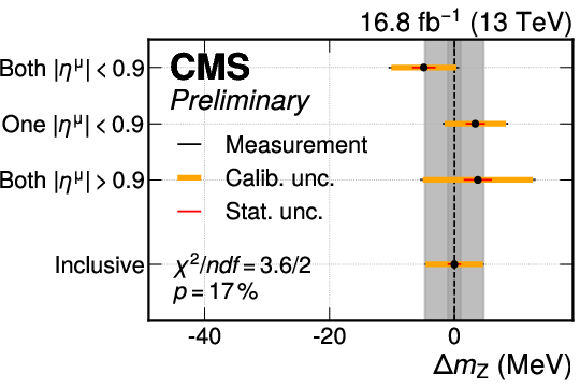
png pdf |
Figure A25-a:
The $ m_{\mathrm{Z}} $ fit split in three bins of kinematics of the two muons: $ |\eta^{\mu}| $ (both central, one central and one forward, and both forward) on the left, and $ \eta^{\mu} $ (both negative, one positive and one negative, and both positive) on the right. The result of a fit with three $ m_{\mathrm{Z}} $ parameters is compared the nominal $ m_{\mathrm{Z}} $ fit result and the $ \chi^2 $-like compatibility of the two fits is also shown, as assessed via the saturated goodness-of-fit test. The results show the uncertainty in $ m_{\mathrm{Z}} $, separating the calibration and statistical uncertainty contributions. |

png pdf |
Figure A25-b:
The $ m_{\mathrm{Z}} $ fit split in three bins of kinematics of the two muons: $ |\eta^{\mu}| $ (both central, one central and one forward, and both forward) on the left, and $ \eta^{\mu} $ (both negative, one positive and one negative, and both positive) on the right. The result of a fit with three $ m_{\mathrm{Z}} $ parameters is compared the nominal $ m_{\mathrm{Z}} $ fit result and the $ \chi^2 $-like compatibility of the two fits is also shown, as assessed via the saturated goodness-of-fit test. The results show the uncertainty in $ m_{\mathrm{Z}} $, separating the calibration and statistical uncertainty contributions. |
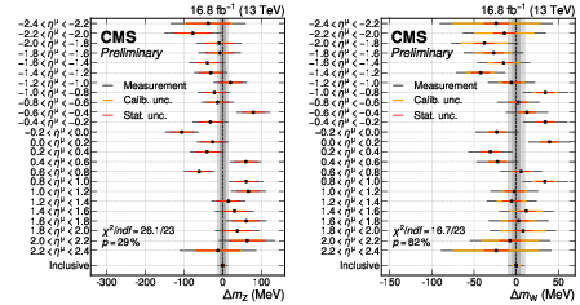
png pdf |
Figure A26:
For the W-like $ m_{\mathrm{Z}} $ analysis (left) and the $ m_{\mathrm{W}} $ measurement (right) the result of a fit with 24 $ m_{\mathrm{V}} $ parameters corresponding to different $ \eta^{\mu} $ ranges is compared with the nominal $ m_{\mathrm{V}} $ fit result. The $ \chi^2 $-like compatibility of the two fits is also shown, assessed via the saturated goodness-of-fit test. The results show the uncertainty in $ m_{\mathrm{V}} $, separating the calibration and statistical uncertainty contributions. |
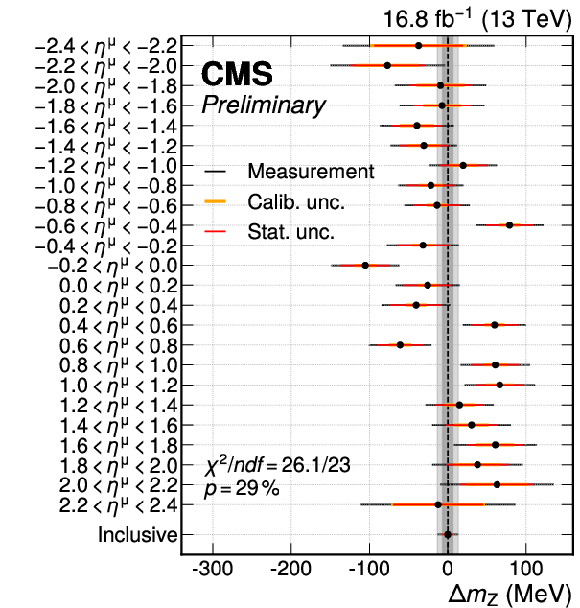
png pdf |
Figure A26-a:
For the W-like $ m_{\mathrm{Z}} $ analysis (left) and the $ m_{\mathrm{W}} $ measurement (right) the result of a fit with 24 $ m_{\mathrm{V}} $ parameters corresponding to different $ \eta^{\mu} $ ranges is compared with the nominal $ m_{\mathrm{V}} $ fit result. The $ \chi^2 $-like compatibility of the two fits is also shown, assessed via the saturated goodness-of-fit test. The results show the uncertainty in $ m_{\mathrm{V}} $, separating the calibration and statistical uncertainty contributions. |
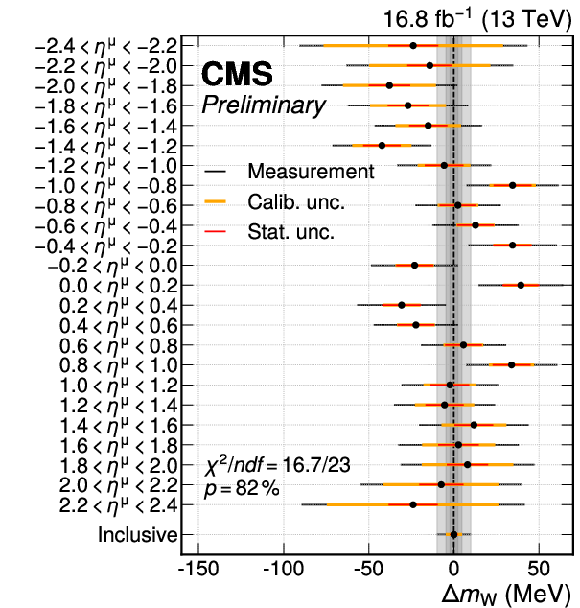
png pdf |
Figure A26-b:
For the W-like $ m_{\mathrm{Z}} $ analysis (left) and the $ m_{\mathrm{W}} $ measurement (right) the result of a fit with 24 $ m_{\mathrm{V}} $ parameters corresponding to different $ \eta^{\mu} $ ranges is compared with the nominal $ m_{\mathrm{V}} $ fit result. The $ \chi^2 $-like compatibility of the two fits is also shown, assessed via the saturated goodness-of-fit test. The results show the uncertainty in $ m_{\mathrm{V}} $, separating the calibration and statistical uncertainty contributions. |
| Tables | |

png pdf |
Table A1:
Breakdown of muon calibration uncertainties. |

png pdf |
Table A2:
Goodness-of-fit test statistics for different PDF sets when fitting simultaneously the $ \eta^{\mu} $ distributions for selected $ \mathrm{W^+} $ ($ \mathrm{W^-} $) events and the $ y^{\mu\mu} $ distribution for $ \mathrm{Z}\to\mu\mu $ events. The fit is performed in the nominal configuration with all uncertainties (left column), nominal configuration without PDF and $ \alpha_{s} $ uncertainties (middle column), and nominal configuration without theory uncertainties (right column). The $ p $-value denotes the probability for the observed data to agree with a given configuration as well as, or worse than, it does. |

png pdf |
Table A3:
Prefit uncertainty scaling factors required to cover the central predictions of the considered PDF sets and postfit impact in $ m_{\mathrm{W}} $, with and without scaled PDF uncertainties. |
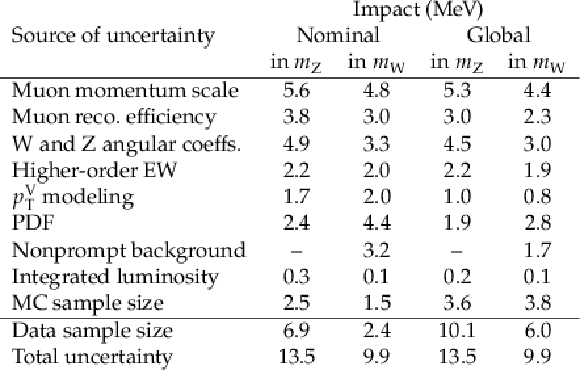
png pdf |
Table A4:
Dominant systematic uncertainties in the W-like $ m_{\mathrm{Z}} $ and $ m_{\mathrm{W}} $ measurements, using the ``nominal'' [none-none-none] and ``global'' [101] definition of the impacts. |
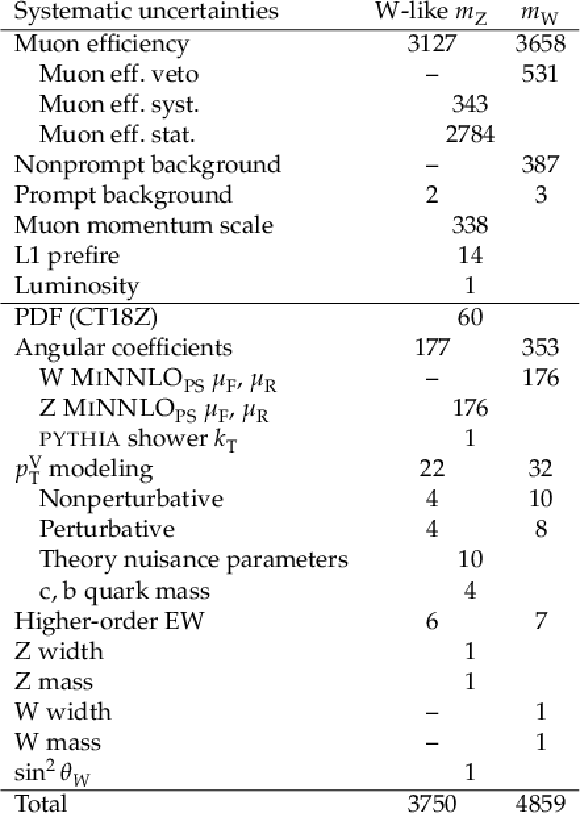
png pdf |
Table A5:
Number of nuisance parameters for the main groups of systematic uncertainties, for the W-like Z and W fits. The measured mass parameter is also included, albeit it is treated in a special way in each fit. The number of parameters is displayed only once when it is the same for both fits, while ``$-$'' means that this source is not relevant. For completeness, subgroups of parameters are also reported as indented labels for a few groups. |
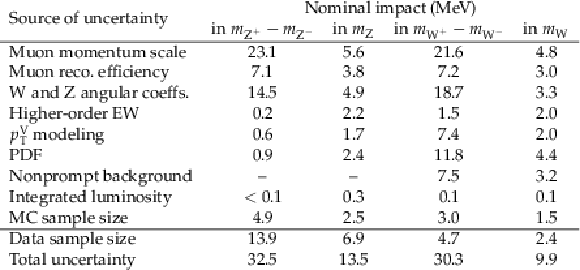
png pdf |
Table A6:
Dominant systematic uncertainties in the W-like $ m_{\mathrm{Z}} $ and $ m_{\mathrm{W}} $ measurements, comparing the mass difference between charges and the nominal charge combination, using nominal impacts. |
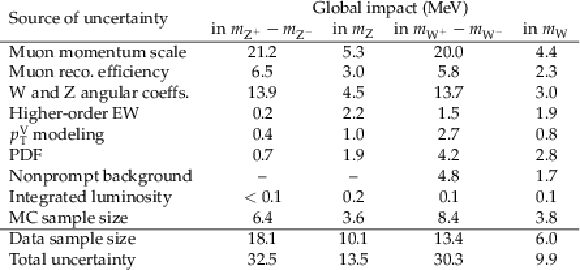
png pdf |
Table A7:
Dominant systematic uncertainties in the W-like $ m_{\mathrm{Z}} $ and $ m_{\mathrm{W}} $ measurements, comparing the mass difference between charges and the nominal charge combination, using global impacts. |
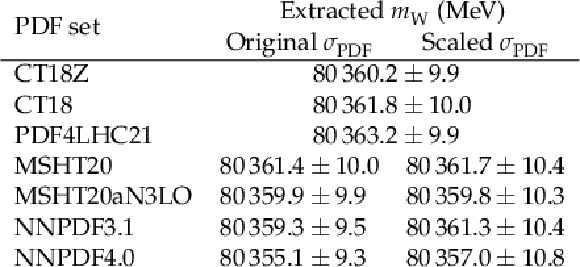
png pdf |
Table A8:
The $ m_{\mathrm{W}} $ values measured for different PDF sets, with uncertainties scaled following the procedure described in Section 11.10 and with the default unscaled uncertainties. |
| Summary |
| In this paper we report the first W mass measurement by the CMS Collaboration at the CERN LHC, with a precision very similar to that of the recent CDF measurement and better than that of all other results. The W mass is extracted from a sample of $ \mathrm{W}\to\mu\nu $ decays, collected in 2016 at the proton-proton collision energy of 13 TeV, via a highly granular maximum likelihood fit to the three-dimensional distribution of the muon $ p_{\mathrm{T}}^{\mu} $, $ \eta^{\mu} $, and electric charge. A number of novel experimental techniques have been used, together with state-of-the-art theoretical models, to improve the measurement accuracy. Both the data analysis methods and the treatment of the theory calculations used in the $ m_{\mathrm{W}} $ measurement have been validated in multiple ways, including a muon momentum calibration using only $ {\mathrm{J}/\psi} \to\mu\mu $ events and the extraction of $ m_{\mathrm{Z}} $ from a W-like analysis of Z boson dimuon decays. The measured value, $ m_{\mathrm{W}} = $ 80 360.2 $ \pm $ 9.9 MeV, agrees with the expectation from the standard model electroweak fit and is consistent with the present world average (excluding CDF), as shown in Fig. 4. This measurement constitutes a significant step towards reaching an experimental value with a precision approaching that of the standard model prediction. |
| Additional Figures | |
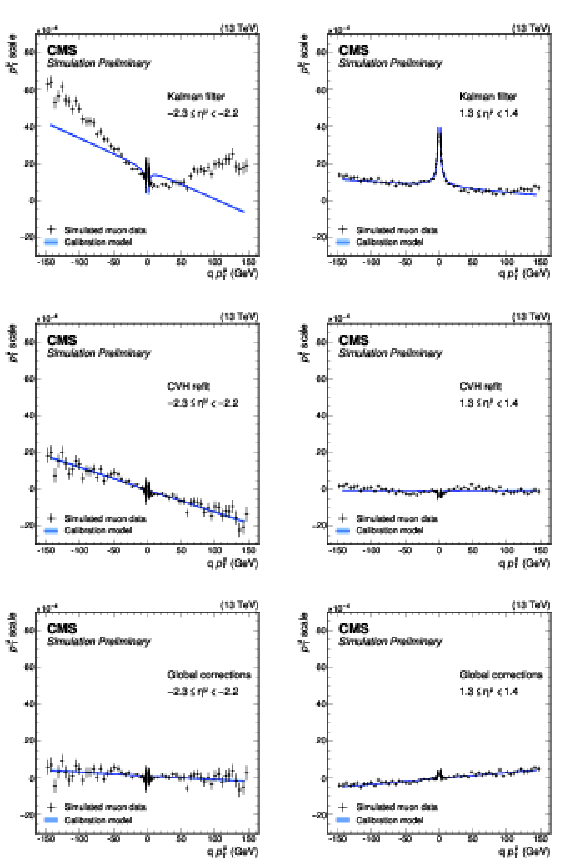
png pdf |
Additional Figure 1:
Comparison between a fit of the calibration model and simulated data after Kalman Filter track fit (top), CVH refit (middle), and generalized global corrections (bottom). The comparison is performed in two muon pseudorapidity bins. |
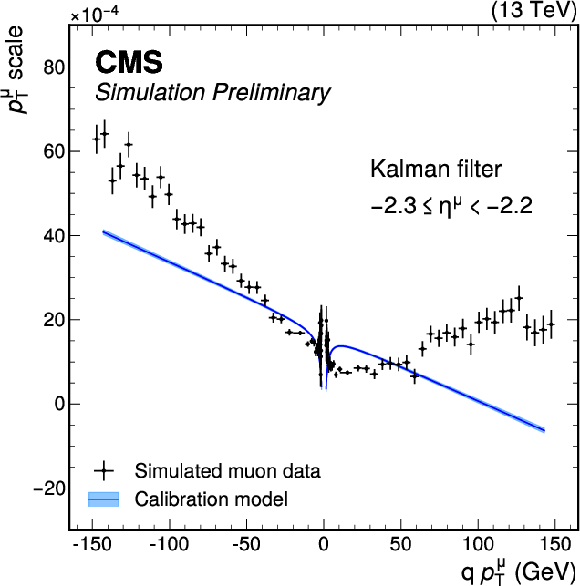
png pdf |
Additional Figure 1-a:
Comparison between a fit of the calibration model and simulated data after Kalman Filter track fit (top), CVH refit (middle), and generalized global corrections (bottom). The comparison is performed in two muon pseudorapidity bins. |
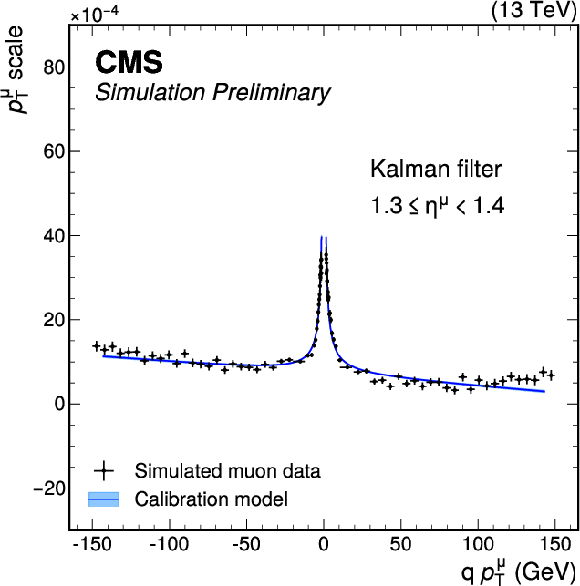
png pdf |
Additional Figure 1-b:
Comparison between a fit of the calibration model and simulated data after Kalman Filter track fit (top), CVH refit (middle), and generalized global corrections (bottom). The comparison is performed in two muon pseudorapidity bins. |

png pdf |
Additional Figure 1-c:
Comparison between a fit of the calibration model and simulated data after Kalman Filter track fit (top), CVH refit (middle), and generalized global corrections (bottom). The comparison is performed in two muon pseudorapidity bins. |
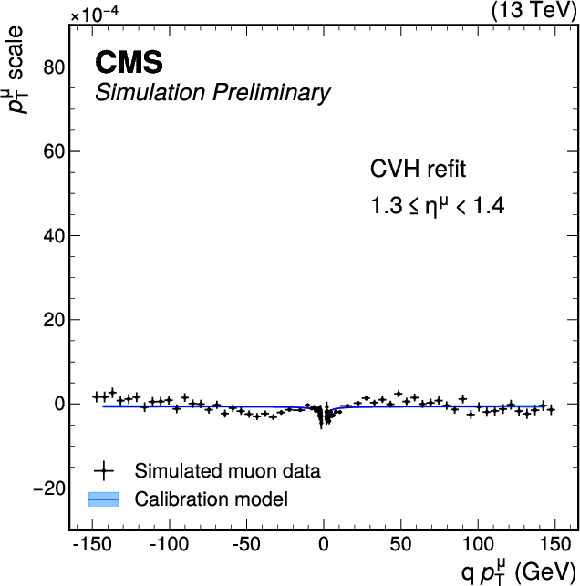
png pdf |
Additional Figure 1-d:
Comparison between a fit of the calibration model and simulated data after Kalman Filter track fit (top), CVH refit (middle), and generalized global corrections (bottom). The comparison is performed in two muon pseudorapidity bins. |
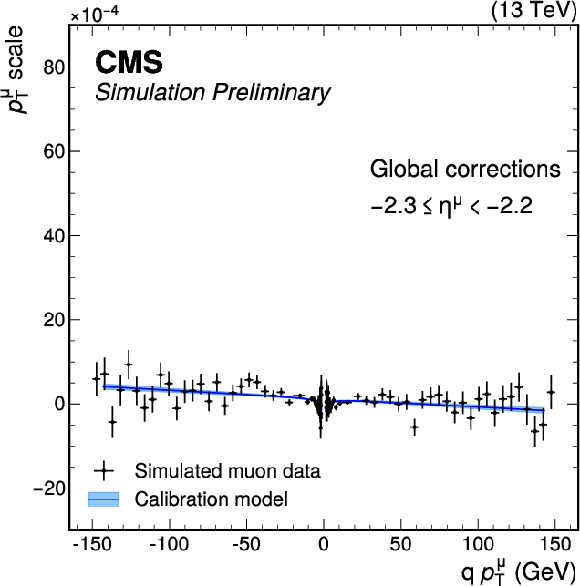
png pdf |
Additional Figure 1-e:
Comparison between a fit of the calibration model and simulated data after Kalman Filter track fit (top), CVH refit (middle), and generalized global corrections (bottom). The comparison is performed in two muon pseudorapidity bins. |
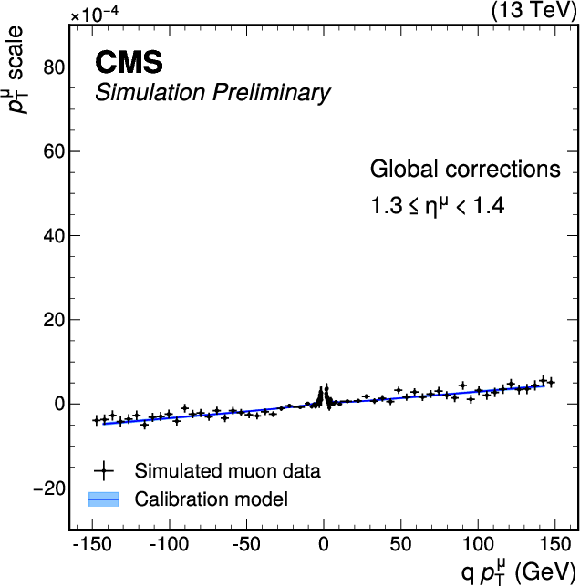
png pdf |
Additional Figure 1-f:
Comparison between a fit of the calibration model and simulated data after Kalman Filter track fit (top), CVH refit (middle), and generalized global corrections (bottom). The comparison is performed in two muon pseudorapidity bins. |
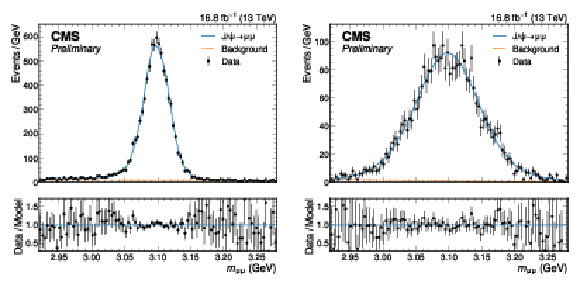
png pdf |
Additional Figure 2:
Example mass fits of $ {\mathrm{J}/\psi} \to\mu\mu $ events in the central (left) and forward (right) region of the detector. |
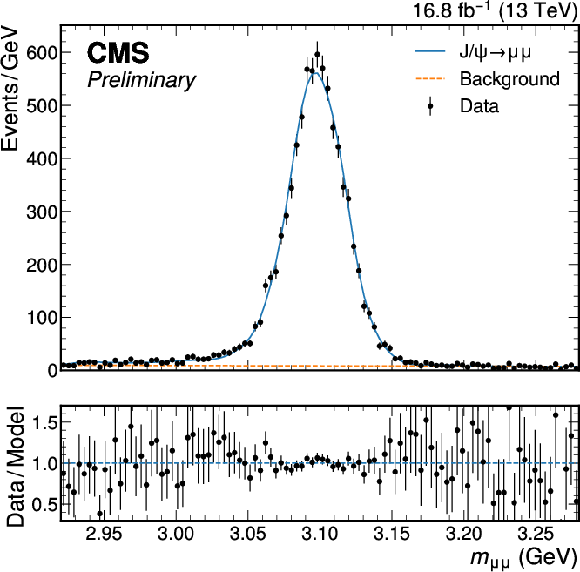
png pdf |
Additional Figure 2-a:
Example mass fits of $ {\mathrm{J}/\psi} \to\mu\mu $ events in the central (left) and forward (right) region of the detector. |
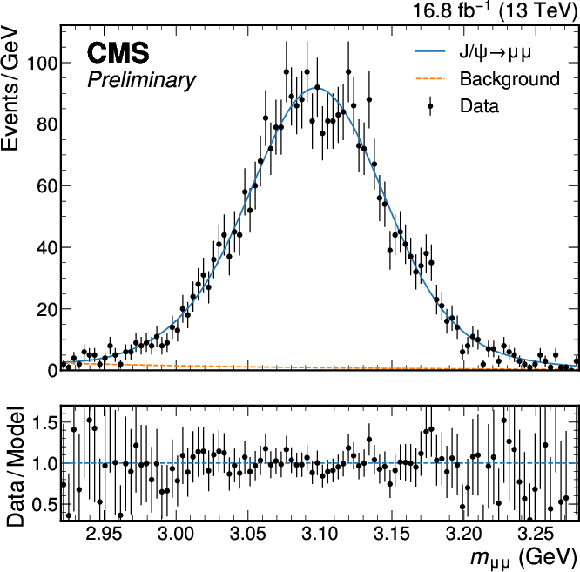
png pdf |
Additional Figure 2-b:
Example mass fits of $ {\mathrm{J}/\psi} \to\mu\mu $ events in the central (left) and forward (right) region of the detector. |
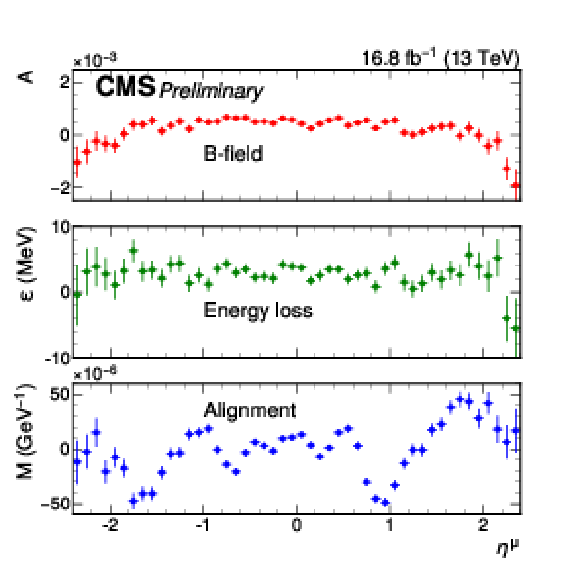
png pdf |
Additional Figure 3:
Extracted muon calibration factors. |
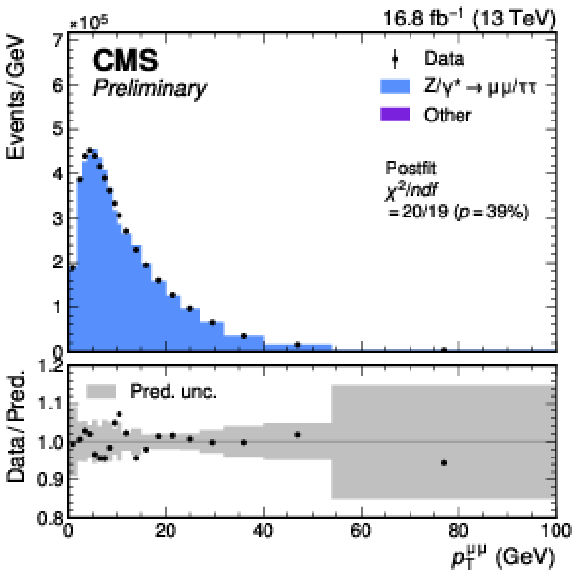
png pdf |
Additional Figure 4:
Measured and predicted $ p_{\mathrm{T}}^{\mu\mu} $ distribution with the prediction adjusted according to the best fit values of the nuisance parameters obtained from the maximum likelihood fit to the $ (p_{\mathrm{T}}^{\mu}, \eta^{\mu}, q^{\mu}) $ distribution with the W-like selection using the helicity fit. The gray band represents the uncertainty in the prediction, after the fit to the $ (p_{\mathrm{T}}^{\mu}, \eta^{\mu}, q^{\mu}) $ data. |
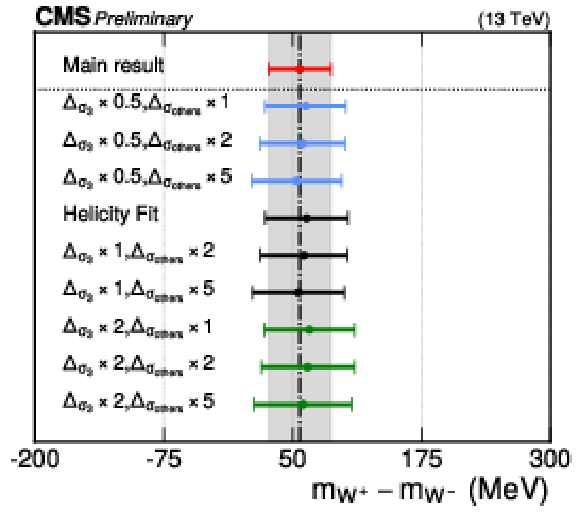
png pdf |
Additional Figure 9:
Measurement of the charge difference between positive and negative W bosons using the Helicity Fit for the nominal configuration and alternative scenarios with modifications to the prefit uncertainty bands. |
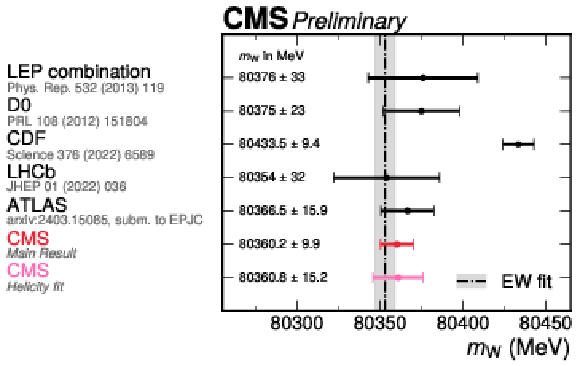
png pdf |
Additional Figure 10:
Summary of W boson mass measurements including the Helicity Fit. |

png pdf |
Additional Figure 11:
The generator-level $ |y^{\mathrm{Z}}| $ distribution, compared to the unfolded data, with the prediction and uncertainty before the maximum likelihood fit and with the distribution modified according to the postfit values and uncertainties of the relevant nuisance parameters. The distribution and uncertainties obtained from the W-like $ m_{\mathrm{Z}} $ measurement are shown in purple, whereas the blue band shows the distribution obtained from the direct fit to the $ p_{\mathrm{T}}^{\mu\mu} $ distribution. The generator-level distribution predicted by SCETLIB+DYTURBO (before incorporating the constraints obtained from fits to the data) is shown in black. The ratio of the predictions and unfolded data to the prefit prediction (shown in gray), as well as their uncertainties, are shown by the shaded bands in the bottom panel. |

png pdf |
Additional Figure 12:
Transverse mass distribution for W events in simulation, reconstructed with DeepMET and with Particle Flow MET. |
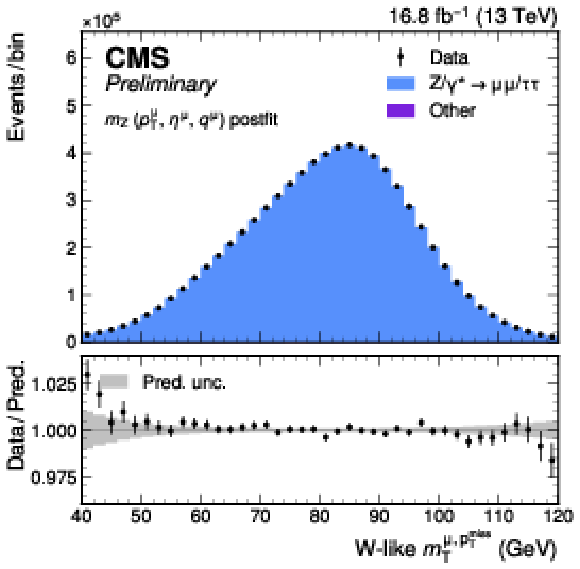
png pdf |
Additional Figure 13:
Measured and predicted transverse mass distribution in $ \mathrm{Z}\to\mu\mu $ events with the W-like Z selection with the prediction adjusted according to the best fit values of the nuisance parameters obtained from the maximum likelihood fit to the $ (p_{\mathrm{T}}^{\mu}, \eta^{\mu}, q^{\mu}) $ distribution. The gray band represents the uncertainty in the prediction, after the fit to the $ (p_{\mathrm{T}}^{\mu}, \eta^{\mu}, q^{\mu}) $ data. |

png pdf |
Additional Figure 14:
For the W-like $ m_{\mathrm{Z}} $ analysis (left) and the $ m_{\mathrm{W}} $ measurement (right) the result of a fit with 48 $ m_{\mathrm{V}} $ parameters corresponding to different $ \eta^{\mu} $ ranges for the two charges is compared with the nominal $ m_{\mathrm{V}} $ fit result. The $ \chi^2 $-like compatibility of the two fits is also shown, assessed via the saturated goodness-of-fit test. The results show the uncertainty in $ m_{\mathrm{V}} $, separating the calibration and statistical uncertainty contributions. |
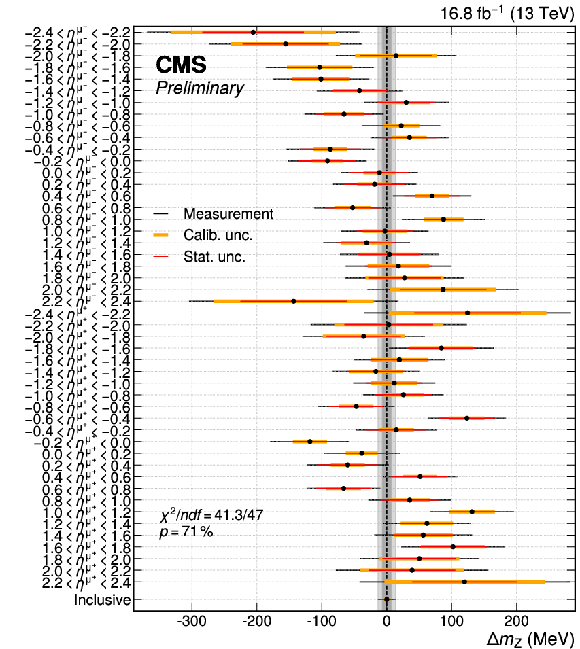
png pdf |
Additional Figure 14-a:
For the W-like $ m_{\mathrm{Z}} $ analysis (left) and the $ m_{\mathrm{W}} $ measurement (right) the result of a fit with 48 $ m_{\mathrm{V}} $ parameters corresponding to different $ \eta^{\mu} $ ranges for the two charges is compared with the nominal $ m_{\mathrm{V}} $ fit result. The $ \chi^2 $-like compatibility of the two fits is also shown, assessed via the saturated goodness-of-fit test. The results show the uncertainty in $ m_{\mathrm{V}} $, separating the calibration and statistical uncertainty contributions. |
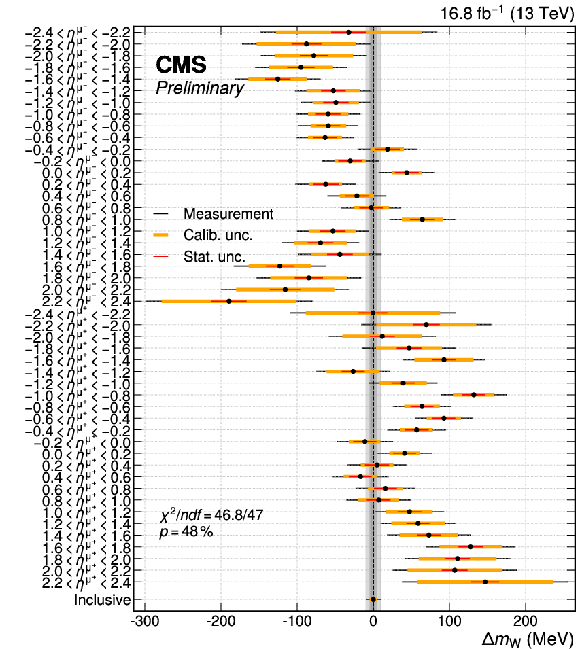
png pdf |
Additional Figure 14-b:
For the W-like $ m_{\mathrm{Z}} $ analysis (left) and the $ m_{\mathrm{W}} $ measurement (right) the result of a fit with 48 $ m_{\mathrm{V}} $ parameters corresponding to different $ \eta^{\mu} $ ranges for the two charges is compared with the nominal $ m_{\mathrm{V}} $ fit result. The $ \chi^2 $-like compatibility of the two fits is also shown, assessed via the saturated goodness-of-fit test. The results show the uncertainty in $ m_{\mathrm{V}} $, separating the calibration and statistical uncertainty contributions. |
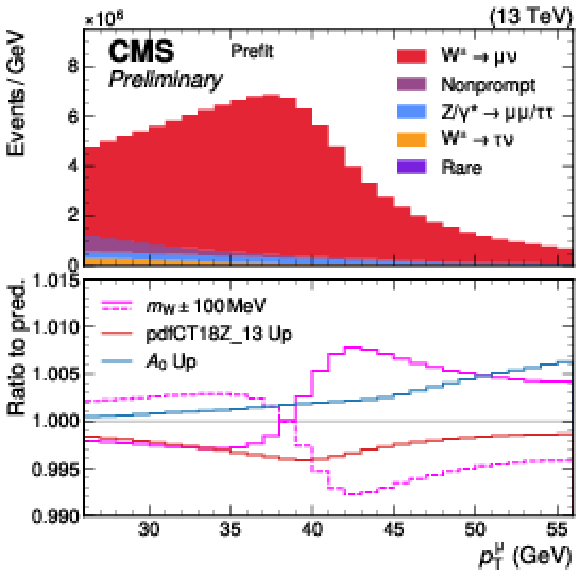
png pdf |
Additional Figure 15:
The $ p_{\mathrm{T}}^{\mu} $ spectrum in simulation, showing variations of one of the eigenvectors of the CT18Z PDF set, and of the $ A_0 $ angular coefficient corresponding to the missing higher order uncertainties as compared to a 100 MeV variation in $ m_{\mathrm{W}} $. |
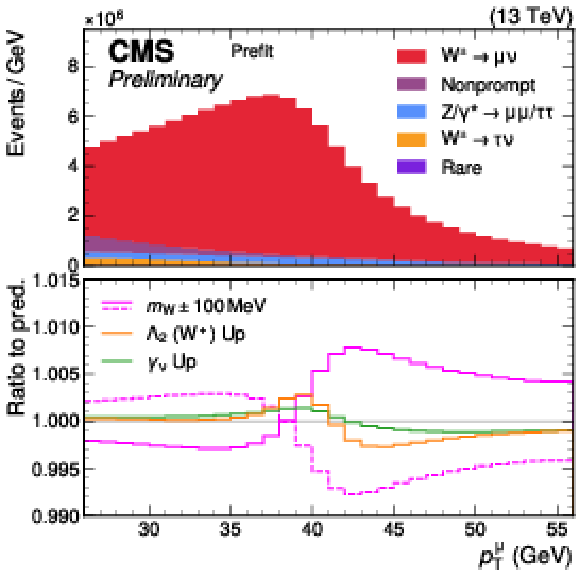
png pdf |
Additional Figure 16:
The $ p_{\mathrm{T}}^{\mu} $ spectrum in simulation, showing variations of two parameters of the non-perturbative model in the $ \mathrm{W} p_{\mathrm{T}} $ modeling as compared to a 100 MeV variation in $ m_{\mathrm{W}} $. |
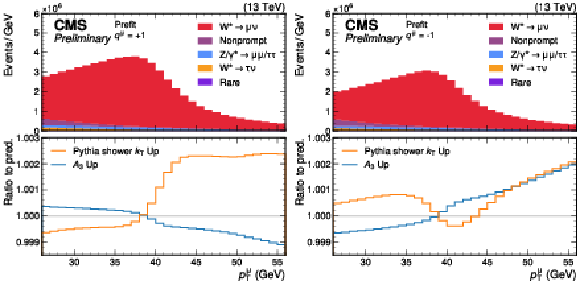
png pdf |
Additional Figure 17:
The $ p_{\mathrm{T}}^{\mu} $ spectrum in simulation for $ \mu^+ $ (left) and $ \mu^- $ (right), showing a variation of the $ A_3 $ angular coefficient corresponding to the missing higher order uncertainties, as well as the variation associated with the effect of the Pythia intrinsic $ k_T $ treatment on the angular coefficients. |
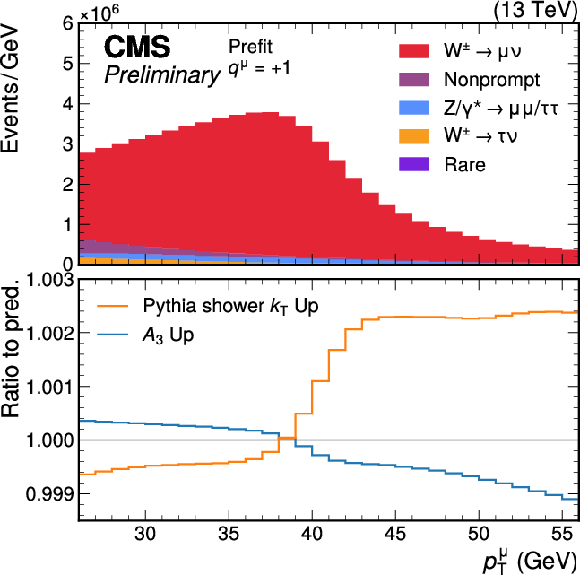
png pdf |
Additional Figure 17-a:
The $ p_{\mathrm{T}}^{\mu} $ spectrum in simulation for $ \mu^+ $ (left) and $ \mu^- $ (right), showing a variation of the $ A_3 $ angular coefficient corresponding to the missing higher order uncertainties, as well as the variation associated with the effect of the Pythia intrinsic $ k_T $ treatment on the angular coefficients. |
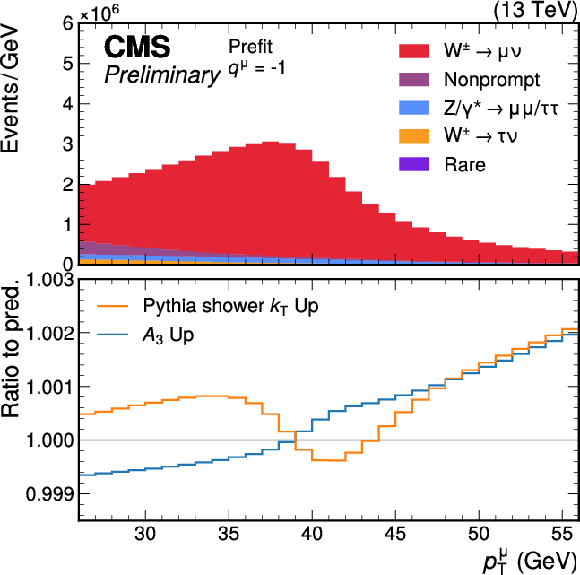
png pdf |
Additional Figure 17-b:
The $ p_{\mathrm{T}}^{\mu} $ spectrum in simulation for $ \mu^+ $ (left) and $ \mu^- $ (right), showing a variation of the $ A_3 $ angular coefficient corresponding to the missing higher order uncertainties, as well as the variation associated with the effect of the Pythia intrinsic $ k_T $ treatment on the angular coefficients. |
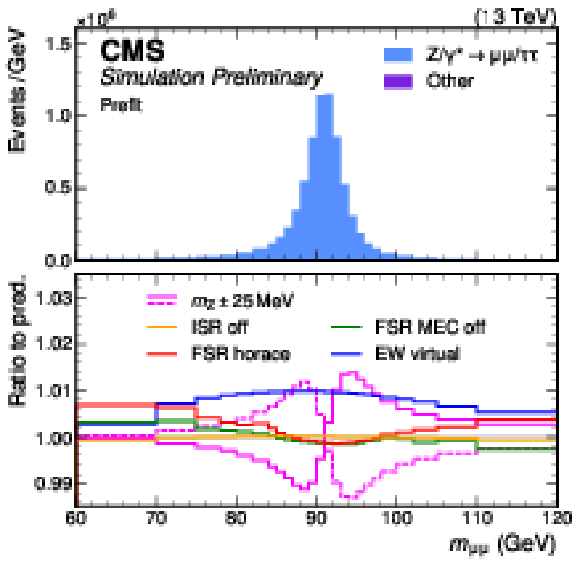
png pdf |
Additional Figure 18:
The $ m_{\mu\mu} $ distribution in simulation showing variations of the electroweak uncertainties as compared to a 25 MeV variation in $ m_{\mathrm{Z}} $. |
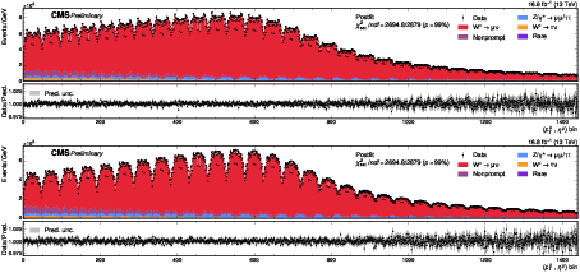
png pdf |
Additional Figure 19:
Measured and predicted $ (p_{\mathrm{T}}^{\mu}, \eta^{\mu}) $ distributions for positively (upper) and negatively (lower) charged muons, with the prediction adjusted according to the best fit values of the nuisance parameters obtained from the maximum likelihood fit. The two-dimensional distribution is ``unrolled" such that each bin on the $ x $-axis represents one $ (p_{\mathrm{T}}^{\mu}, \eta^{\mu}) $ cell. The gray band represents the uncertainty in the prediction, after the fit to the data. |

png pdf |
Additional Figure 19-a:
Measured and predicted $ (p_{\mathrm{T}}^{\mu}, \eta^{\mu}) $ distributions for positively (upper) and negatively (lower) charged muons, with the prediction adjusted according to the best fit values of the nuisance parameters obtained from the maximum likelihood fit. The two-dimensional distribution is ``unrolled" such that each bin on the $ x $-axis represents one $ (p_{\mathrm{T}}^{\mu}, \eta^{\mu}) $ cell. The gray band represents the uncertainty in the prediction, after the fit to the data. |

png pdf |
Additional Figure 19-b:
Measured and predicted $ (p_{\mathrm{T}}^{\mu}, \eta^{\mu}) $ distributions for positively (upper) and negatively (lower) charged muons, with the prediction adjusted according to the best fit values of the nuisance parameters obtained from the maximum likelihood fit. The two-dimensional distribution is ``unrolled" such that each bin on the $ x $-axis represents one $ (p_{\mathrm{T}}^{\mu}, \eta^{\mu}) $ cell. The gray band represents the uncertainty in the prediction, after the fit to the data. |
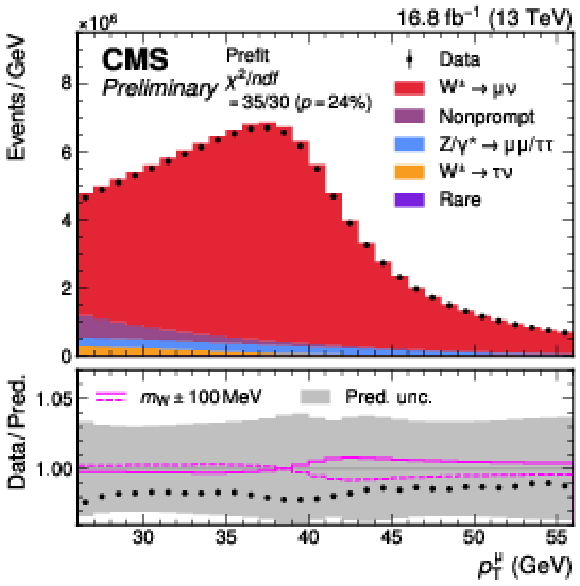
png pdf |
Additional Figure 20:
Measured and simulated $ p_{\mathrm{T}}^{\mu} $ distributions, The solid and dashed pink lines represent, respectively, an increase and decrease of $ m_{\mathrm{W}} $ by 100 MeV. The uncertainties in the predictions, before the systematic uncertainty profiling in the maximum likelihood fit, are shown by the shaded band. |
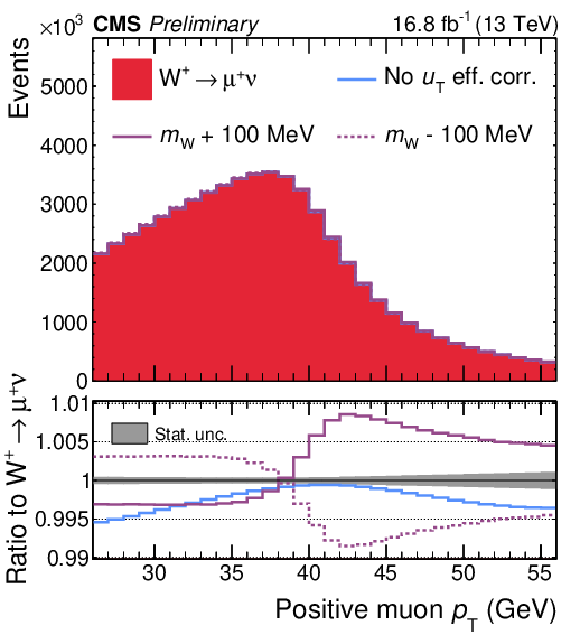
png pdf |
Additional Figure 21:
The $ p_{\mathrm{T}}^{\mu} $ spectrum in simulation for $ \mu^+ $ events, showing the effect of neglecting the hadronic recoil dependence of the isolation and trigger efficiency scale factors, as compared to a 100 MeV variation in $ m_{\mathrm{W}} $. |
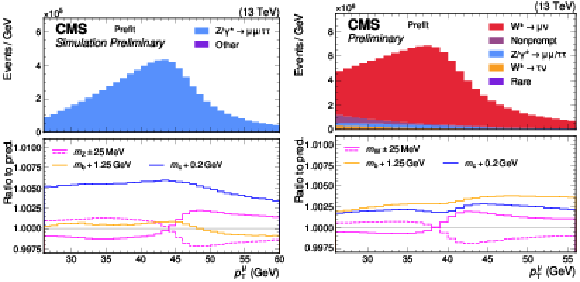
png pdf |
Additional Figure 22:
Variations of quark masses in the variable flavor scheme MSHT PDF set for the muon from the Z (left) and W (right) compared to a 25 MeV variation of the masses of the bosons. |

png pdf |
Additional Figure 22-a:
Variations of quark masses in the variable flavor scheme MSHT PDF set for the muon from the Z (left) and W (right) compared to a 25 MeV variation of the masses of the bosons. |
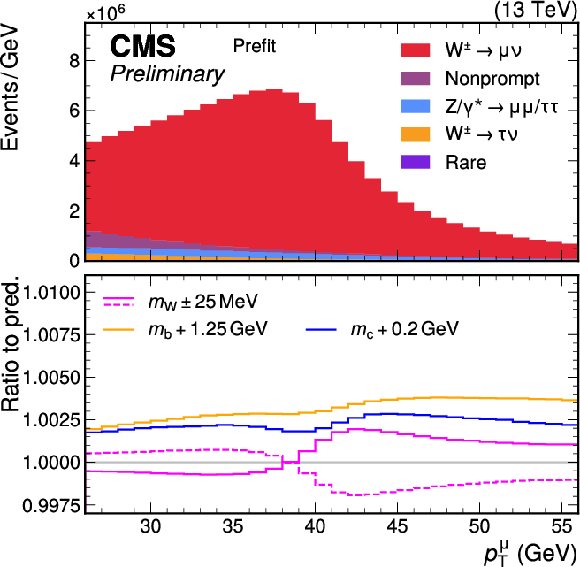
png pdf |
Additional Figure 22-b:
Variations of quark masses in the variable flavor scheme MSHT PDF set for the muon from the Z (left) and W (right) compared to a 25 MeV variation of the masses of the bosons. |

png pdf |
Additional Figure 23:
Variations of $ m_{\mathrm{W}} $ by $ \pm $ 10 MeV for selected W events compared to the nominal prediction. |
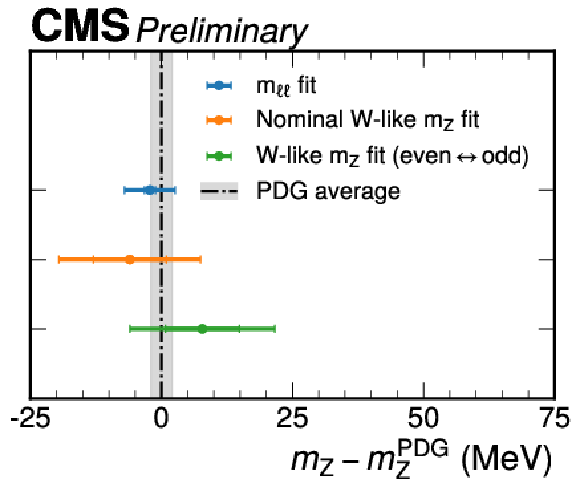
png pdf |
Additional Figure 24:
Summary of extracted $ m_{\mathrm{Z}} $ values as compared to the PDG value. |

png pdf |
Additional Figure 25:
The $ m_{\mathrm{W}} $ measurement from this analaysis, and CMS measurements of $ m_\mathrm{t} $ and $ \sin^2\theta_{\mathrm{W}} $ are compared with the EW fit prediction in the $ m_\mathrm{t} \mbox{\textsl{vs.}} m_{\mathrm{W}} $ plane (left) and the $ \sin^2\theta_{\mathrm{W}} $ vs $ m_{\mathrm{W}} $ plane (right). |
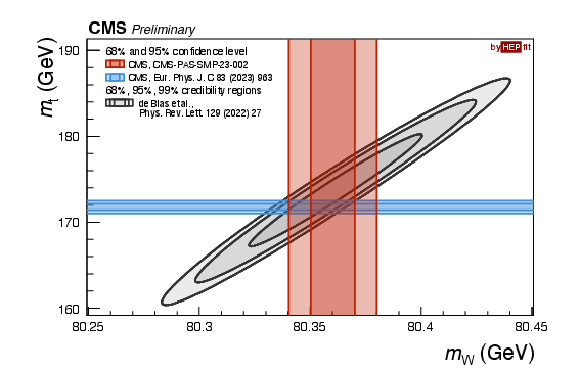
png pdf |
Additional Figure 25-a:
The $ m_{\mathrm{W}} $ measurement from this analaysis, and CMS measurements of $ m_\mathrm{t} $ and $ \sin^2\theta_{\mathrm{W}} $ are compared with the EW fit prediction in the $ m_\mathrm{t} \mbox{\textsl{vs.}} m_{\mathrm{W}} $ plane (left) and the $ \sin^2\theta_{\mathrm{W}} $ vs $ m_{\mathrm{W}} $ plane (right). |
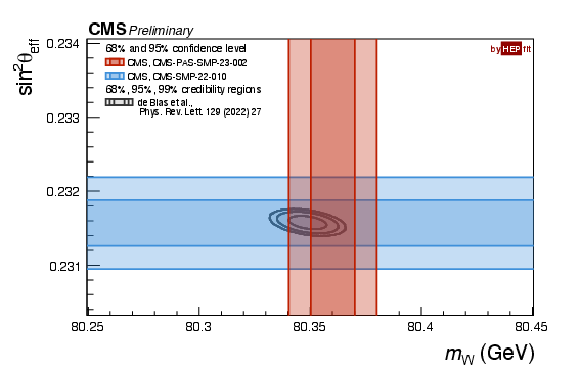
png pdf |
Additional Figure 25-b:
The $ m_{\mathrm{W}} $ measurement from this analaysis, and CMS measurements of $ m_\mathrm{t} $ and $ \sin^2\theta_{\mathrm{W}} $ are compared with the EW fit prediction in the $ m_\mathrm{t} \mbox{\textsl{vs.}} m_{\mathrm{W}} $ plane (left) and the $ \sin^2\theta_{\mathrm{W}} $ vs $ m_{\mathrm{W}} $ plane (right). |
| References | ||||
| 1 | Particle Data Group, S. Navas et al. | Review of Particle Physics | PRD 110 (2024) 030001 | |
| 2 | ATLAS Collaboration | Observation of a new particle in the search for the Standard Model Higgs boson with the ATLAS detector at the LHC | PLB 716 (2012) 1 | 1207.7214 |
| 3 | CMS Collaboration | Observation of a new boson at a mass of 125 GeV with the CMS experiment at the LHC | PLB 716 (2012) 30 | CMS-HIG-12-028 1207.7235 |
| 4 | CMS Collaboration | Observation of a new boson with mass near 125 GeV in pp collisions at $ \sqrt{s} = $ 7 and 8 TeV | JHEP 06 (2013) 081 | CMS-HIG-12-036 1303.4571 |
| 5 | CMS Collaboration | A measurement of the Higgs boson mass in the diphoton decay channel | PLB 805 (2020) 135425 | CMS-HIG-19-004 2002.06398 |
| 6 | ATLAS Collaboration | Combined measurement of the Higgs boson mass from the $ \mathrm{H} \to \gamma\gamma $ and $ \mathrm{H} \to \mathrm{Z}\mathrm{Z}^* \to 4 \ell $ decay channels with the ATLAS detector using $ \sqrt{s} = $ 7, 8, and 13 TeV pp collision data | PRL 131 (2023) 251802 | 2308.04775 |
| 7 | S. Heinemeyer, W. Hollik, G. Weiglein, and L. Zeune | Implications of LHC search results on the W boson mass prediction in the MSSM | JHEP 12 (2013) 084 | 1311.1663 |
| 8 | D. López-Val and T. Robens | $ \Delta $r and the W-boson mass in the singlet extension of the standard model | PRD 90 (2014) 114018 | 1406.1043 |
| 9 | ALEPH, DELPHI, L3, OPAL, LEP Electroweak Working Group, S. Schael et al. | Electroweak measurements in electron-positron collisions at W-boson-pair energies at LEP | Phys. Rept. 532 (2013) 119 | 1302.3415 |
| 10 | CDF Collaboration | First measurement of the W boson mass in Run II of the Tevatron | PRL 99 (2007) 151801 | 0707.0085 |
| 11 | CDF Collaboration | First Run II measurement of the W boson mass | PRD 77 (2008) 112001 | 0708.3642 |
| 12 | D0 Collaboration | Measurement of the W boson mass | PRL 103 (2009) 141801 | 0908.0766 |
| 13 | CDF Collaboration | Precise measurement of the W-boson mass with the CDF II detector | PRL 108 (2012) 151803 | 1203.0275 |
| 14 | D0 Collaboration | Measurement of the W boson mass with the D0 detector | PRL 108 (2012) 151804 | 1203.0293 |
| 15 | D0 Collaboration | Measurement of the W boson mass with the D0 detector | PRD 89 (2014) 012005 | 1310.8628 |
| 16 | CDF Collaboration | Precise measurement of the W-boson mass with the Collider Detector at Fermilab | PRD 89 (2014) 072003 | 1311.0894 |
| 17 | CDF Collaboration | High-precision measurement of the W boson mass with the CDF II detector | Science 376 (2022) 170 | |
| 18 | ATLAS Collaboration | Measurement of the W-boson mass in pp collisions at $ \sqrt{s} = $ 7 TeV with the ATLAS detector | EPJC 78 (2018) 110 | 1701.07240 |
| 19 | LHCb Collaboration | Measurement of the W boson mass | JHEP 01 (2022) 036 | 2109.01113 |
| 20 | ATLAS Collaboration | Measurement of the W-boson mass and width with the ATLAS detector using proton-proton collisions at $ \sqrt{s} = $ 7 TeV | 2403.15085 | |
| 21 | LHC-TeV MW Working Group, S. Amoroso et al. | Compatibility and combination of world W-boson mass measurements | EPJC 84 (2024) 451 | 2308.09417 |
| 22 | F. J. Tackmann | Theory uncertainties and correlations from theory nuisance parameters | SCET 2024 workshop link |
|
| 23 | F. J. Tackmann | Beyond scale variations: perturbative theory uncertainties from nuisance parameters | DESY-19-021, to appear (2024) | |
| 24 | E. Manca, O. Cerri, N. Foppiani, and G. Rolandi | About the rapidity and helicity distributions of the W bosons produced at LHC | JHEP 12 (2017) 130 | 1707.09344 |
| 25 | S. Farry, O. Lupton, M. Pili, and M. Vesterinen | Understanding and constraining the PDF uncertainties in a W boson mass measurement with forward muons at the LHC | EPJC 79 (2019) 497 | 1902.04323 |
| 26 | CMS Collaboration | Measurements of the W boson rapidity, helicity, double-differential cross sections, and charge asymmetry in $ {\mathrm{p}\mathrm{p}} $ collisions at 13 TeV | PRD 102 (2020) 092012 | CMS-SMP-18-012 2008.04174 |
| 27 | E. Mirkes | Angular decay distribution of leptons from W bosons at NLO in hadronic collisions | NPB 387 (1992) 3 | |
| 28 | CMS Collaboration | W-like measurement of the Z boson mass using dimuon events collected in pp collisions at $ \sqrt{s} = $ 7 TeV | CMS Physics Analysis Summary, 2016 link |
CMS-PAS-SMP-14-007 |
| 29 | CMS Collaboration | Precision luminosity measurement in proton-proton collisions at $ \sqrt{s} = $ 13 TeV in 2015 and 2016 at CMS | EPJC 81 (2021) 800 | CMS-LUM-17-003 2104.01927 |
| 30 | P. F. Monni et al. | MiNNLO$ _\mathrm{PS} $: a new method to match NNLO QCD to parton showers | JHEP 05 (2020) 143 | 1908.06987 |
| 31 | P. F. Monni, E. Re, and M. Wiesemann | MiNNLO$ _{\mathrm{PS}} $: optimizing 2 $ \to $ 1 hadronic processes | EPJC 80 (2020) 1075 | 2006.04133 |
| 32 | P. Nason | A new method for combining NLO QCD with shower Monte Carlo algorithms | JHEP 11 (2004) 040 | hep-ph/0409146 |
| 33 | S. Frixione, P. Nason, and C. Oleari | Matching NLO QCD computations with parton shower simulations: the POWHEG method | JHEP 11 (2007) 070 | 0709.2092 |
| 34 | S. Alioli, P. Nason, C. Oleari, and E. Re | A general framework for implementing NLO calculations in shower Monte Carlo programs: the POWHEG BOX | JHEP 06 (2010) 043 | 1002.2581 |
| 35 | T. Sjöstrand et al. | An introduction to PYTHIA 8.2 | Comput. Phys. Commun. 191 (2015) 159 | 1410.3012 |
| 36 | P. Golonka and Z. Was | PHOTOS Monte Carlo: a precision tool for QED corrections in Z and W decays | EPJC 45 (2006) 97 | hep-ph/0506026 |
| 37 | N. Davidson, T. Przedzinski, and Z. Was | PHOTOS interface in C++: Technical and physics documentation | Comput. Phys. Commun. 199 (2016) 86 | 1011.0937 |
| 38 | M. A. Ebert, J. K. L. Michel, I. W. Stewart, and F. J. Tackmann | Drell-Yan $ q_{\mathrm{T}} $ resummation of fiducial power corrections at N$ ^{3} $LL | JHEP 04 (2021) 102 | 2006.11382 |
| 39 | G. Billis, M. A. Ebert, J. K. L. Michel, and F. J. Tackmann | A toolbox for $ q_{\mathrm{T}} $ and 0-jettiness subtractions at N$ ^3 $LO | Eur. Phys. J. Plus 136 (2021) 214 | 1909.00811 |
| 40 | S. Camarda et al. | DYTurbo: Fast predictions for Drell-Yan processes | EPJC 80 (2020) 251 | 1910.07049 |
| 41 | GEANT4 Collaboration | GEANT 4--a simulation toolkit | NIM A 506 (2003) 250 | |
| 42 | CMS Collaboration | Performance of the CMS muon detector and muon reconstruction with proton-proton collisions at $ \sqrt{s} = $ 13 TeV | JINST 13 (2018) P06015 | CMS-MUO-16-001 1804.04528 |
| 43 | CMS Collaboration | Electron and photon reconstruction and identification with the CMS experiment at the CERN LHC | JINST 16 (2021) P05014 | CMS-EGM-17-001 2012.06888 |
| 44 | CMSnoop | A new deep-neural-network-based missing transverse momentum estimator, and its application to W recoil | \hrefY.~Feng, . PhD thesis, University of Maryland, College Park, 2020 link |
|
| 45 | S. Choi and H. Oh | Improved extrapolation methods of data-driven background estimations in high energy physics | EPJC 81 (2021) 643 | 1906.10831 |
| 46 | J. S. Conway | Incorporating nuisance parameters in likelihoods for multisource spectra | in PHYSTAT 2011: Workshop on statistical issues related to discovery claims in search experiments and unfolding, H.B. Prosper and L. Lyons, eds., CERN Yellow Reports, 2011 link |
1103.0354 |
| 47 | R. J. Barlow and C. Beeston | Fitting using finite Monte Carlo samples | Comput. Phys. Commun. 77 (1993) 219 | |
| 48 | C.-A. Alexe, J. L. Bendavid, L. Bianchini, and D. Bruschini | Undercoverage in high-statistics counting experiments with finite MC samples | 2401.10542 | |
| 49 | B. Efron | Bootstrap methods: another look at the jackknife | in Breakthroughs in statistics: methodology and distribution, S. Kotz and N.L. Johnson, eds., Springer, New York, NY, 1992 link |
|
| 50 | M. Abadi et al. | TensorFlow: Large-scale machine learning on heterogeneous distributed systems | Software available from tensorflow.org |
1603.04467 |
| 51 | R. D. Cousins | Lectures on statistics in theory: prelude to statistics in practice | 1807.05996 | |
| 52 | CMS Collaboration | The CMS experiment at the CERN LHC | JINST 3 (2008) S08004 | |
| 53 | CMS Collaboration | Performance of the CMS Level-1 trigger in proton-proton collisions at $ \sqrt{s} = $ 13 TeV | JINST 15 (2020) P10017 | CMS-TRG-17-001 2006.10165 |
| 54 | CMS Collaboration | The CMS trigger system | JINST 12 (2017) P01020 | CMS-TRG-12-001 1609.02366 |
| 55 | CMS Collaboration | Description and performance of track and primary-vertex reconstruction with the CMS tracker | JINST 9 (2014) P10009 | CMS-TRK-11-001 1405.6569 |
| 56 | CMS Collaboration | Particle-flow reconstruction and global event description with the CMS detector | JINST 12 (2017) P10003 | CMS-PRF-14-001 1706.04965 |
| 57 | CMS Collaboration | Performance of reconstruction and identification of $ \tau $ leptons decaying to hadrons and $ \nu_\tau $ in pp collisions at $ \sqrt{s} = $ 13 TeV | JINST 13 (2018) P10005 | CMS-TAU-16-003 1809.02816 |
| 58 | CMS Collaboration | Jet energy scale and resolution in the CMS experiment in in pp collisions at 8 TeV | JINST 12 (2017) P02014 | CMS-JME-13-004 1607.03663 |
| 59 | CMS Collaboration | Performance of missing transverse momentum reconstruction in proton-proton collisions at $ \sqrt{s} = $ 13 TeV using the CMS detector | JINST 14 (2019) P07004 | CMS-JME-17-001 1903.06078 |
| 60 | CMS Collaboration | Extraction and validation of a new set of CMS PYTHIA8 tunes from underlying-event measurements | EPJC 80 (2020) 4 | CMS-GEN-17-001 1903.12179 |
| 61 | CMS Collaboration | Measurements of differential Z boson production cross sections in proton-proton collisions at $ \sqrt{s} = $ 13 TeV | JHEP 12 (2019) 061 | CMS-SMP-17-010 1909.04133 |
| 62 | T.-J. Hou et al. | New CTEQ global analysis of quantum chromodynamics with high-precision data from the LHC | PRD 103 (2021) 014013 | 1912.10053 |
| 63 | NNPDF Collaboration | Parton distributions from high-precision collider data | EPJC 77 (2017) 663 | 1706.00428 |
| 64 | NNPDF Collaboration | The path to proton structure at 1\% accuracy | EPJC 82 (2022) 428 | 2109.02653 |
| 65 | S. Bailey et al. | Parton distributions from LHC, HERA, Tevatron and fixed target data: MSHT20 PDFs | EPJC 81 (2021) 341 | 2012.04684 |
| 66 | PDF4LHC Working Group Collaboration | The PDF4LHC21 combination of global PDF fits for the LHC Run III | JPG 49 (2022) 080501 | 2203.05506 |
| 67 | T. Cridge, L. A. Harland-Lang, and R. S. Thorne | Combining QED and approximate N$ ^3 $LO QCD corrections in a global PDF fit: MSHT20qed_an3lo PDFs | SciPost Phys. 17 (2024) 026 | 2312.07665 |
| 68 | M. Grazzini, S. Kallweit, and M. Wiesemann | Fully differential NNLO computations with MATRIX | EPJC 78 (2018) 537 | 1711.06631 |
| 69 | J. Campbell and T. Neumann | Precision phenomenology with MCFM | JHEP 12 (2019) 034 | 1909.09117 |
| 70 | NNPDF Collaboration | Illuminating the photon content of the proton within a global PDF analysis | SciPost Phys. 5 (2018) 008 | 1712.07053 |
| 71 | J. Alwall et al. | The automated computation of tree-level and next-to-leading order differential cross sections, and their matching to parton shower simulations | JHEP 07 (2014) 079 | 1405.0301 |
| 72 | CMS Collaboration | Strategies and performance of the CMS silicon tracker alignment during LHC Run 2 | NIM A 1037 (2022) 166795 | CMS-TRK-20-001 2111.08757 |
| 73 | CMS Collaboration | Measurements of inclusive W and Z cross sections in pp collisions at $ \sqrt{s} = $ 7 TeV | JHEP 01 (2011) 080 | CMS-EWK-10-002 1012.2466 |
| 74 | M. J. Oreglia | A study of the reactions $ \psi^\prime \to \gamma \gamma \psi $ | PhD thesis, Stanford University, 1980 link |
|
| 75 | CMS Collaboration | Performance of the CMS muon trigger system in proton-proton collisions at $ \sqrt{s} = $ 13 TeV | JINST 16 (2021) P07001 | CMS-MUO-19-001 2102.04790 |
| 76 | V. Blobel, C. Kleinwort, and F. Meier | Fast alignment of a complex tracking detector using advanced track models | Comput. Phys. Commun. 182 (2011) 1760 | 1103.3909 |
| 77 | V. Blobel | A new fast track-fit algorithm based on broken lines | NIM A 566 (2006) 14 | |
| 78 | J. Allison et al. | GEANT 4 developments and applications | IEEE Trans. Nucl. Sci. 53 (2006) 270 | |
| 79 | J. Allison et al. | Recent developments in GEANT 4 | NIM A 835 (2016) 186 | |
| 80 | V. Klyukhin et al. | The CMS magnetic field measuring and monitoring systems | Symmetry 14 (2022) 169 | 2202.02562 |
| 81 | CMS Collaboration | Alignment of the CMS tracker with LHC and cosmic ray data | JINST 9 (2014) P06009 | CMS-TRK-11-002 1403.2286 |
| 82 | G. Billis, J. K. L. Michel, and F. J. Tackmann | Drell-Yan transverse-momentum spectra at N$ ^3 $LL$ ^\prime $ and approximate N$ ^4 $LL with SCETlib | DESY-23-081, MIT-CTP/5572, Nikhef 2024-007, to appear (2024) | |
| 83 | C. W. Bauer, D. Pirjol, and I. W. Stewart | Soft collinear factorization in effective field theory | PRD 65 (2002) 054022 | hep-ph/0109045 |
| 84 | W. Bizon et al. | Momentum-space resummation for transverse observables and the Higgs p$ _{\perp} $ at N$ ^{3} $LL+NNLO | JHEP 02 (2018) 108 | 1705.09127 |
| 85 | M. A. Ebert, J. K. L. Michel, I. W. Stewart, and Z. Sun | Disentangling long and short distances in momentum-space TMDs | JHEP 07 (2022) 129 | 2201.07237 |
| 86 | S. Berge, P. M. Nadolsky, and F. I. Olness | Heavy-flavor effects in soft gluon resummation for electroweak boson production at hadron colliders | PRD 73 (2006) 013002 | hep-ph/0509023 |
| 87 | P. Pietrulewicz, D. Samitz, A. Spiering, and F. J. Tackmann | Factorization and resummation for massive quark effects in exclusive Drell-Yan | JHEP 08 (2017) 114 | 1703.09702 |
| 88 | T. Cridge, L. A. Harland-Lang, A. D. Martin, and R. S. Thorne | An investigation of the $ \alpha_S $ and heavy quark mass dependence in the MSHT20 global PDF analysis | EPJC 81 (2021) 744 | 2106.10289 |
| 89 | J. C. Collins and D. E. Soper | Angular distribution of dileptons in high-energy hadron collisions | PRD 16 (1977) 2219 | |
| 90 | C. M. Carloni Calame, G. Montagna, O. Nicrosini, and M. Treccani | Higher order QED corrections to W boson mass determination at hadron colliders | PRD 69 (2004) 037301 | hep-ph/0303102 |
| 91 | C. M. Carloni Calame, G. Montagna, O. Nicrosini, and M. Treccani | Multiple photon corrections to the neutral-current Drell-Yan process | JHEP 05 (2005) 019 | hep-ph/0502218 |
| 92 | L. Barze et al. | Neutral current Drell-Yan with combined QCD and electroweak corrections in the POWHEG BOX | EPJC 73 (2013) 2474 | 1302.4606 |
| 93 | M. Chiesa, C. L. Del Pio, and F. Piccinini | On electroweak corrections to neutral current Drell-Yan with the POWHEG BOX | EPJC 84 (2024) 539 | 2402.14659 |
| 94 | S. Bondarenko et al. | Hadron-hadron collision mode in ReneSANCe-v1.3.0 | Comput. Phys. Commun. 285 (2023) 108646 | 2207.04332 |
| 95 | L. Barze et al. | Implementation of electroweak corrections in the POWHEG BOX: single W production | JHEP 04 (2012) 037 | 1202.0465 |
| 96 | S. Alioli et al. | Precision studies of observables in $ \mathrm{p}\mathrm{p} \to \mathrm{W} \to l\nu_{\ell}$ and $ \mathrm{p}\mathrm{p} \to \gamma, \, Z \to \ell^+ \ell^- $ processes at the LHC | EPJC 77 (2017) 280 | 1606.02330 |
| 97 | A. Pinto et al. | Uncertainty components in profile likelihood fits | EPJC 84 (2024) 593 | 2307.04007 |

|
Compact Muon Solenoid LHC, CERN |

|

|

|

|

|

|